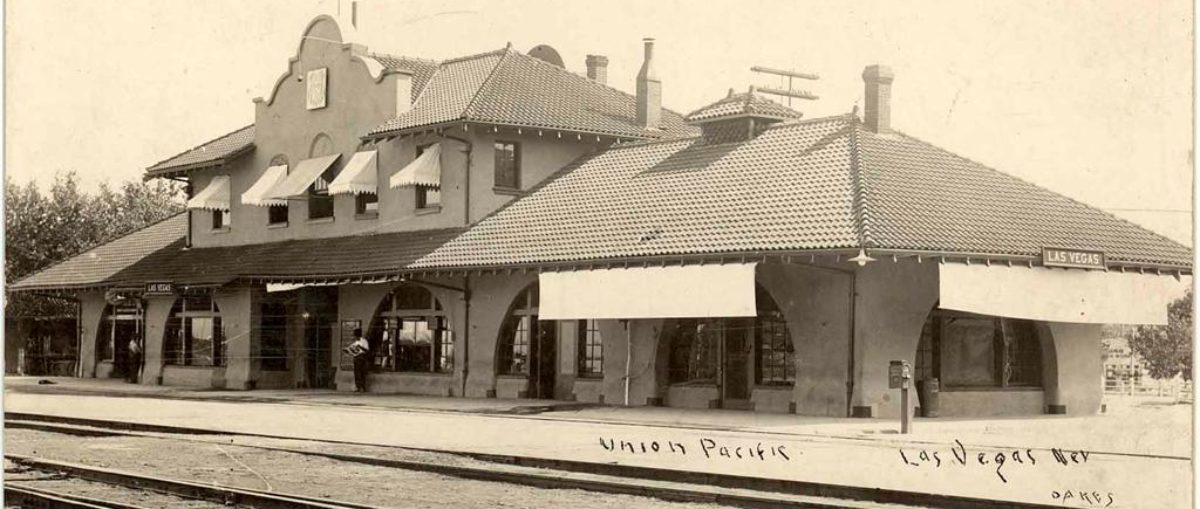Tonopah 1907 -1908
The “A. J.” Series, Published by the Oscar Newman Post Card Company, Los Angeles
By Robert Stoldal
(updated February 13, 2021, February 15, 2021, February 16, 2021, updated February 26, 2021, March 31, 2021.)
A.J. The Tonopah, Nevada Series
The early 20th-century mining boom of west-central Nevada would create the historic community of Tonopah.
Initially known as Butler, Tonopah now serves as the capital of Nye County.
It was the mineral wealth of Tonopah that brought miners, investors, and the spotlight to central Nevada in 1901.
Today, like most of west-central Nevada, mining continues to be an important part of its economy.
Tonopah maintains its leadership role as the largest city and promoting central Nevada’s future and actively preserving the area’s history.
From miners to stockbrokers Tonopah and its neighbor, Goldfield, in the earliest months of the 1900s became magnets for entrepreneurs in all fields.
Starting in Europe, another booming business was spreading across the United States; post cards.
Picture post cards, comic post cards, post cards made of metal, wood, and leather, penny post cards were becoming the communication coin of the realm.
The silver and gold boom of central Nevada matched the beginning of what is known as the Golden Age of post cards.
Large cities would have several stores that only sold post cards, while in smaller, newer towns like Tonopah and Goldfield, initially, it was the drug store that stock the cards.
In the early years of Tonopah, the Miner’s Drug Store run by its owner John Augustus Uhland had the largest supply of post cards.
The boom in post cards received an added push in 1907 when the U.S. Post office changed an important rule.
Effective March of 1907, the post office said you could now write a message on the back of the post card.
Until that point, only a stamp and an address were allowed on the back.
If you wanted to write a message, you had to squeeze it around or over the image on the front of the post card.
Post card salesman from all the major U.S. printing companies found their way to central Nevada.
Opening in 1904, one of the west coast’s largest operations was The Newman Post Card Company of Los Angeles.
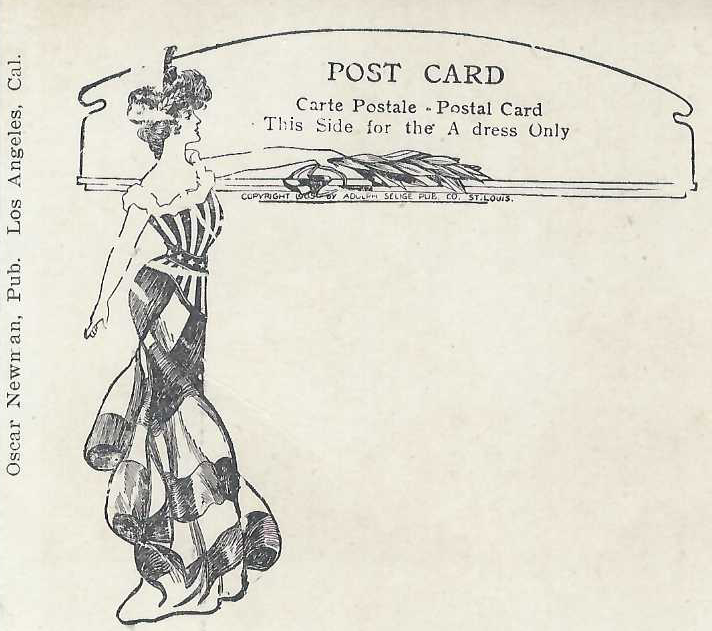
Owned and operated by Oscar Newman, his company used both U.S. and German printing companies to produce post cards.
Initially, Newman focused his business on the population of southern California.
With the opening in 1905 of the rail line between Los Angeles and Salt Lake City, he began to produce post cards to sell on the trains and at the depots along the “Salt Lake Route.”
As the metallic boom was reaching its peak, a railroad was built from Las Vegas to the central part of the state.
There is little doubt post card and novelty salesmen were among the passengers on the first trains heading north.
It was during this period Newman published five series of post cards featuring views of Nevada.
From Las Vegas to Reno, his sales team stayed close to the western edge of Nevada, producing more than seventy different color images of Nevada.
This report will focus on the post cards in Newman’s “A. J.” series.
They are known as the “Tonopah series” since most cards are connected to the community.
In addition to using phrases like “Early days,” and “Early mode of transportation” in the captions, this series of views provides the viewer with images of the earliest days of Tonopah.
The series of cards also includes contemporary images of the community when the cards went on sale in 1908.
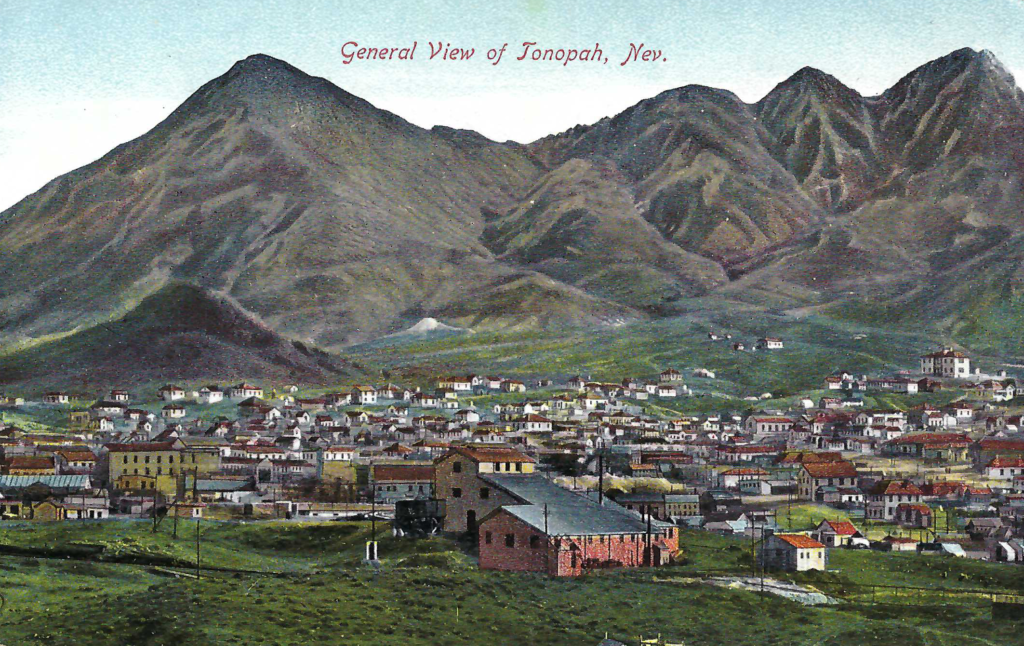
While Newman’s used both U.S. and German printers, all of the Nevada post cards he published, including the A. J. series were printed in Germany.
The images in the A. J. series are superior to those in Newsman’s other Nevada post cards for two reasons.
First, the colors used in the A.J. series are more natural, and second, a different printing process was used, providing a sharper image.
However, like many post cards printed and ‘colored’ in Germany, desert landscape turned from brown to lush green. This is true in the A.J. series.
Newman would be involved in producing post cards of Nevada for two years, starting in 1907.
The A. J. series, Newman’s last Nevada work, was printed in the early Spring of 1908.
There was a three-month period between sending the photographs to be turned into post cards in Germany, the printing and shipping the cards back to the United States.
It is likely the post card order was sent to Germany in early February of 1908, as postmarks show the cards went on sale no later than early May. Tonopah in May of 1908.
The initial print order likely was at least one thousand.
The post cards appeared to have been actively sold for five years.
Currently, known postmarks drop dramatically in 1913, a year before World War One started in Europe.
Were post cards, including Newman’s, printed in Germany pulled from the shelves as the war began in Europe in 1914?
The United States did not join the Allied war effort until 1917.
The Goldfield Connection to the A.J. Tonopah Series
There are two Goldfield connections to the A.J. Tonopah series.
First, scenes from Tonopah were retitled as being in Goldfield.
Three of the post cards, A. J. 16 The Can House, Tonopah, Nev., A.J. 18 Burrow fast express, Tonopah, Nev., and A. J. 21 A Dugout, Tonopah, Nev. were also released with the location being Goldfield.
The Tonopah, Nev. pat of the caption was blocked out with red ink, and directly below, in red in, Goldfield, Nev. printed.
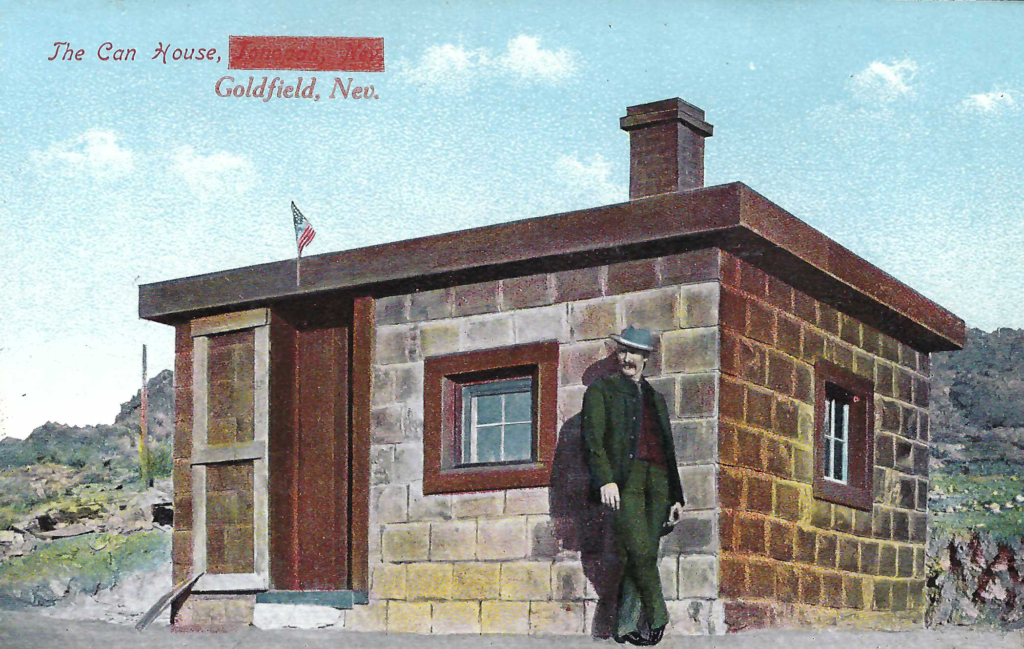
The second Goldfield connection is the work of pioneer western photographer, Pers Edward Larson. The photographer’s busienss was based in Goldfield. Several of the photographs in the A.J. series are Larsen’s and are views of Goldfield.
A.J. 2, with the caption The wandering Moses 40 years on the Desert, uses both a Larson photograph and the title Laron used when he published the photograph as a post card in 1907.
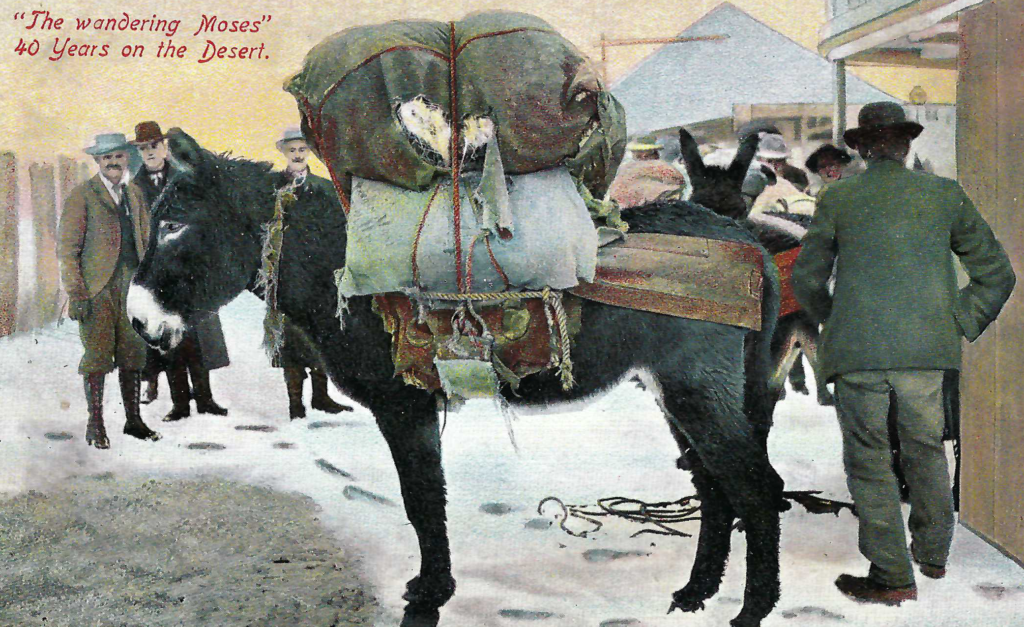
The title for A.J. 2 does not include the location. However, an earlier post card published by Larson includes Goldfield in the caption.
By the time the A.J. Tonopah series went on sale in 1908, Larson had moved out of state. He sold his photographs, equipment, and studio to the photographic team of Welch and Tune. The two men were based in Goldfield as well. Either Larson solid the rights to his photographs to Newman, or Welch and Tune did, or Newman ‘borrowed’ the images.
A key question remains unanswered; who selected the images to be printed in the twenty-three post cards in the A.J. Tonopah series?
A.J. Series, the back of the post card and two numbers
With the exception of the last three post cards in the A.J. series, the back of each post card is identical.
In addition, the last three post cards, while listed in this report, are not views of Tonopah.
The A.J. Tonopah series, cards one to 23, have two numbers printed on the back.
The first number is listed next to A.J. on the left edge of the card. This number indicates the sequence of the cards in the series.
The other number found on the lower back right edge is the number the German printer assigned to the negative or printing plate of the photograph used on the card.
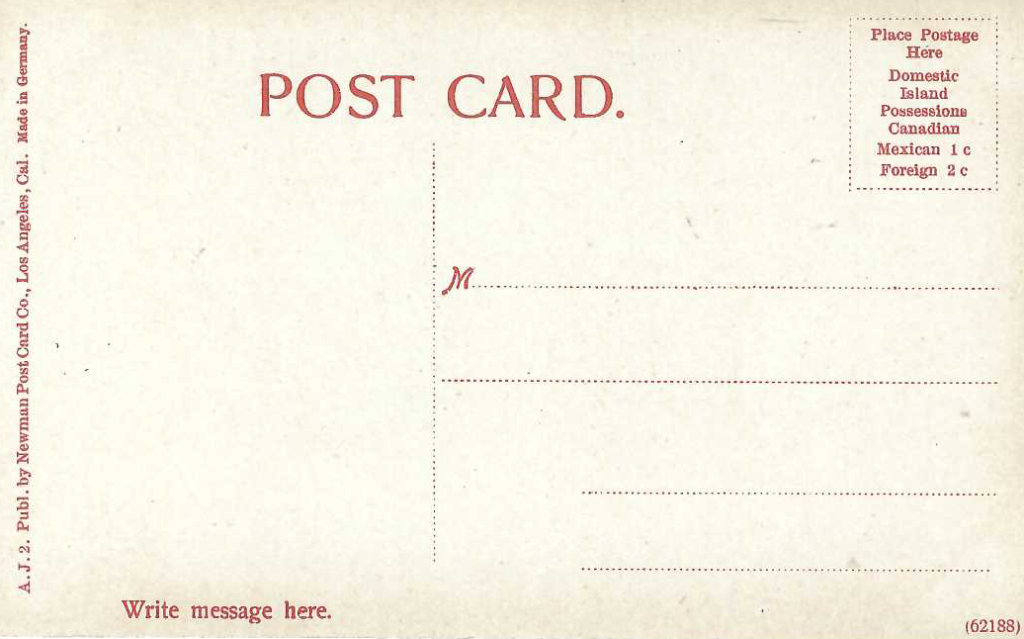
Both the A.J. and 132 Newman series contain the same views of Tonopah
The A.J. series is the second set of post cards Newman published of Tonopah.
Just over half of the photographs used in the A. J. series are used in the 132 series. The 132 series presents a cross-section of Tonopah life circa 1906-1907
While the coloring scheme is distinctly different, the same photographs and captions are used in the 132 series were reused in the A.J. series.
List of matching images in the A.J. and 132 Tonopah post card set.
- A.J. 1 and 132/19
- A.J. 7 and 132/3.
- A.J. 8, and 132/8.
- A.J. 10, and 132/6.
- A.J. 13, and 132/2.
- A.J. 14, and 132/5.
- A.J. 15, and 132/7.
- A.J. 16, and 132/27.
- A.J. 18, and 132/25.
- A.J. 19, and 132/12.
- A.J. 20 and 132/9.
- A.J. 21, and 132/16.
- A.J. 22, and 132/26.
A.J. Tonopah Series Check List and Notes
The following is a list of all the post cards in the A.J. series, along with notes comparing the production to other post cards with the same views published by other companies.
The letters A. and J. as part of the alphanumeric code on the back of the post cards have no connection to Nevada. Newman used the code as part of his record-keeping of the post cards he produced.
A.J. 1 Tonopah and Manhattan Stage Line.
This view is also found in the 132 series published by Newman as post card number 19.

The A. J. 1. version of the stage line
Ahh the green (Springtime) of the desert in the eyes of the German artists who ‘touched up’ this black and white photograph. It is clear the artist did spend more time on the details of the horses and the stagecoach, including the wheels.
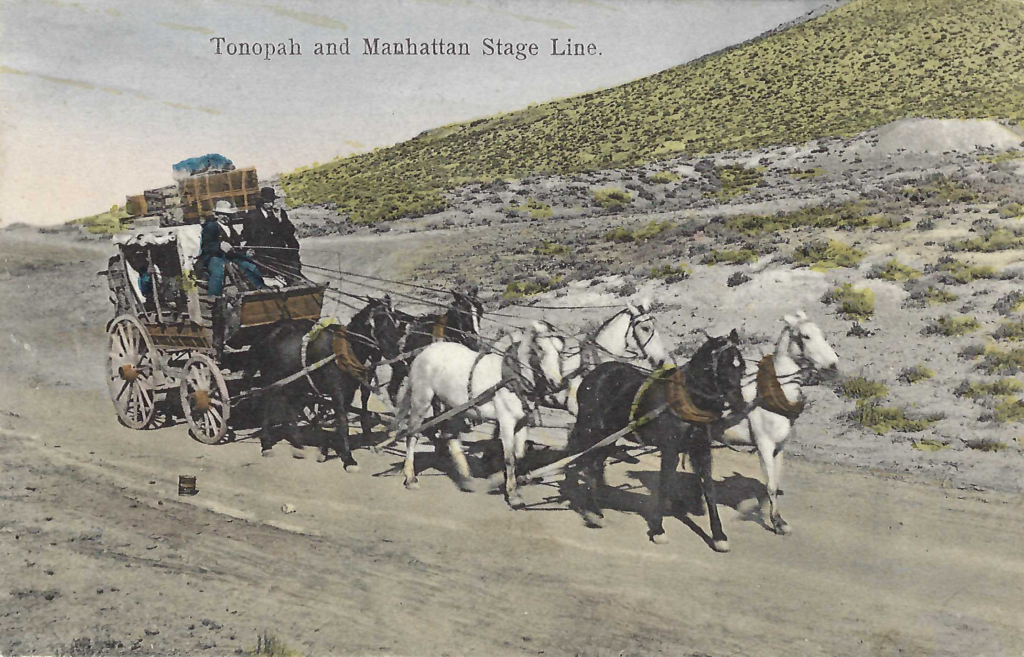
The Newman 132 series, Number 19th.
While the colors in the 132 series image are limited, the view does include the markers where the photographer wanted the stage driver to stop for the photograph. Both objects, a can and part of a skull? are gone from the A.J. post card.
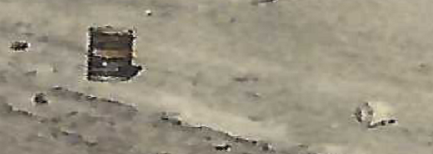
A.J. 2 “The wandering Moses” 40 Years on the Desert.
This view was first published by Larson with an undivided back with the title, THE WANDERING MOSES 40 YEARS ON THE DESERT GOLDFIELD, NEV LARSON PHO 4227. No printer is listed on the undivided back Larson post card.
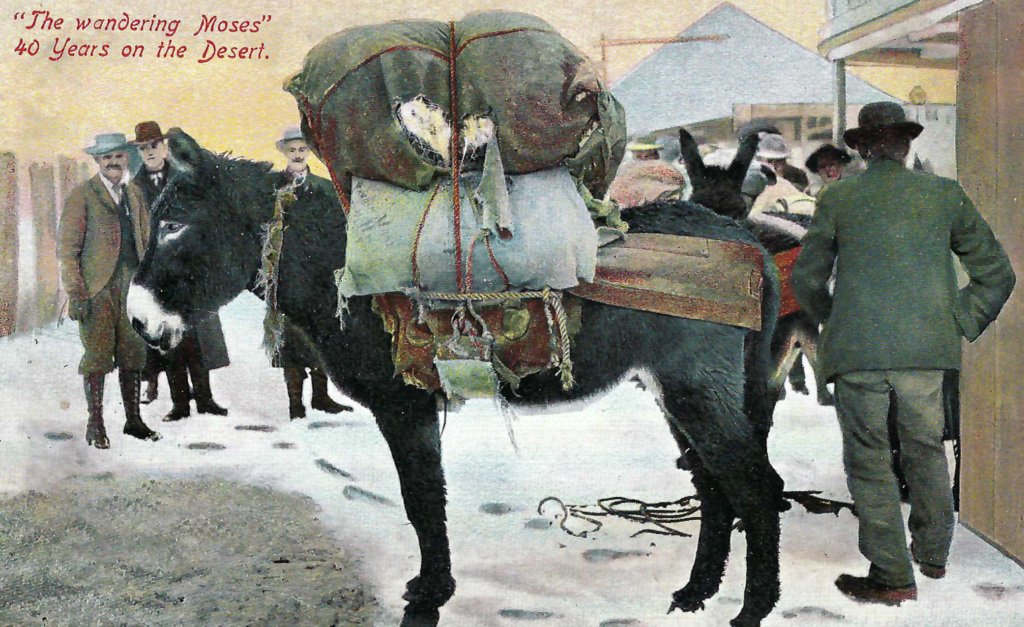
A.J. 3 “A Hold Up” U. S. Mail Coach en route to Bullfrog, Nevada
This view was one of the top sellers reprinted several times by different post card publishers.
The “hold up” title is another from the wit and imagination of Larson, who took the photograph used on the card.
The view shows two stagecoaches, with ten men and one woman. Several of the passengers, including the one woman, are standing off to the side of the coaches.
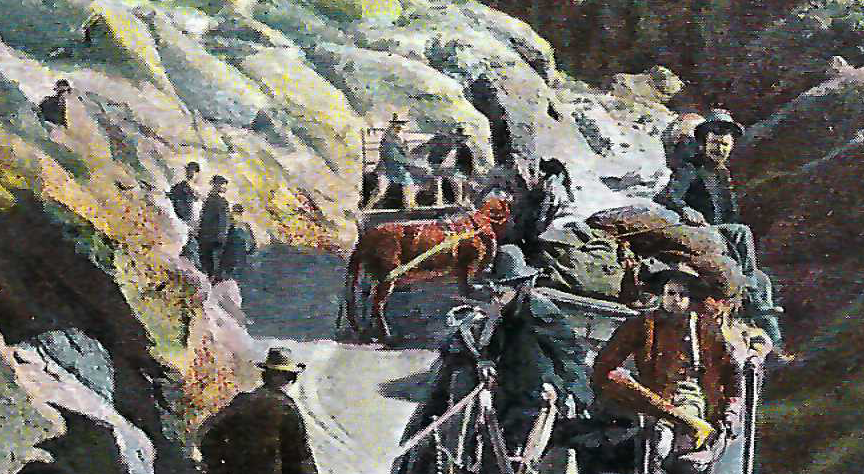
The coach driver on the stagecoach in the background appears to be having trouble handling his horses.
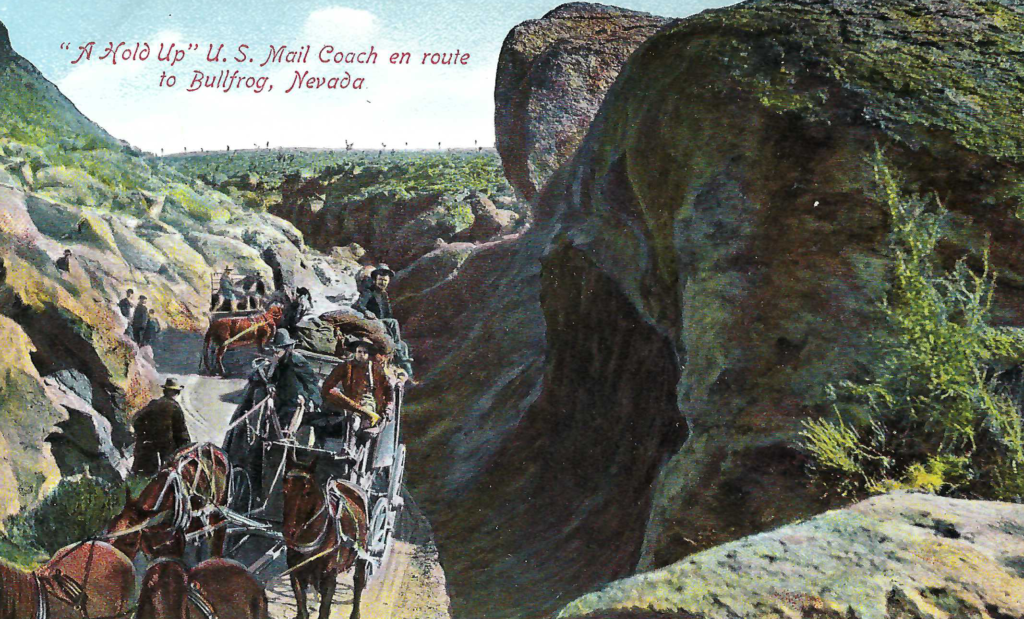
The photograph was likely first issued by Larson, with the title A HOLD UP U.S. MAIL COACH EN ROUTE TO BULLFROG, NEV. LARSON PHO. No. 333 on the face of the post card.
Based on Larson’s photo number, 333, the original photograph was exposed in the late fall of 1905.
Larson used the same photograph for the Newman Post Card Company on the fifth post card in the 134 series.
This photograph is also seen on a post card published by the Dennison News Company. The Dennison view, number three, is titled, U.S. Mail Coach En Route to Bullfrog, Nevada.
Another post card with the same view, no publisher listed, is titled GOLDFIELD NEV 1907 O’ KEEFE BROS. STAGE CO LEVAEING BULLFROG NEV. HEADiNG FOR GOLDFIELD. Note the misspelling of Leaving in the caption.
A.J. 4 Bird’s Eye View of Tonopah, Nev., from Mt. Oddie.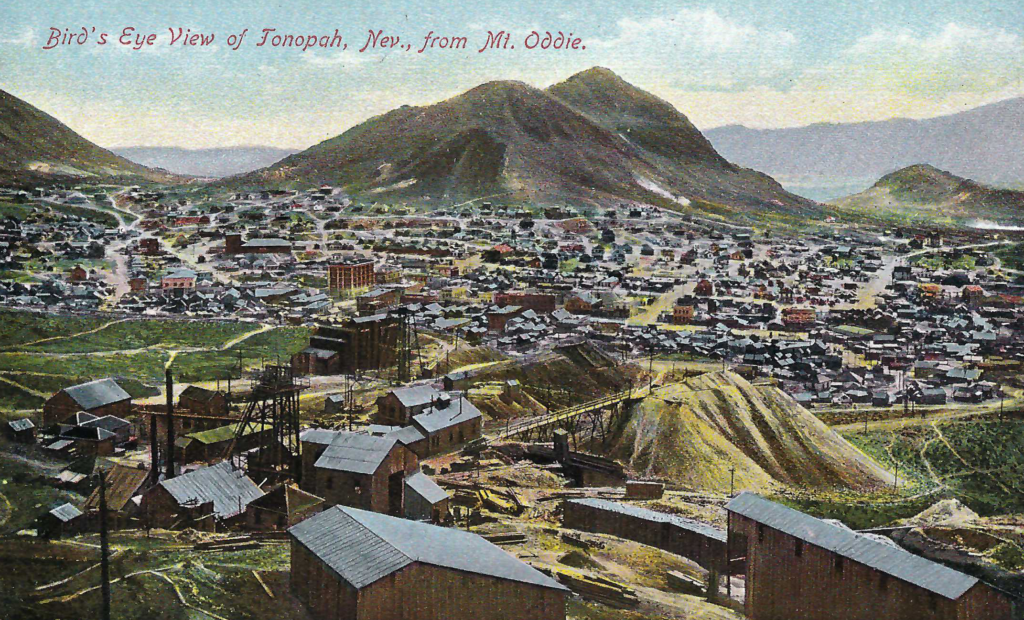
A.J. 5 State Bank and Trust Co. Building, Tonopah, Nev. 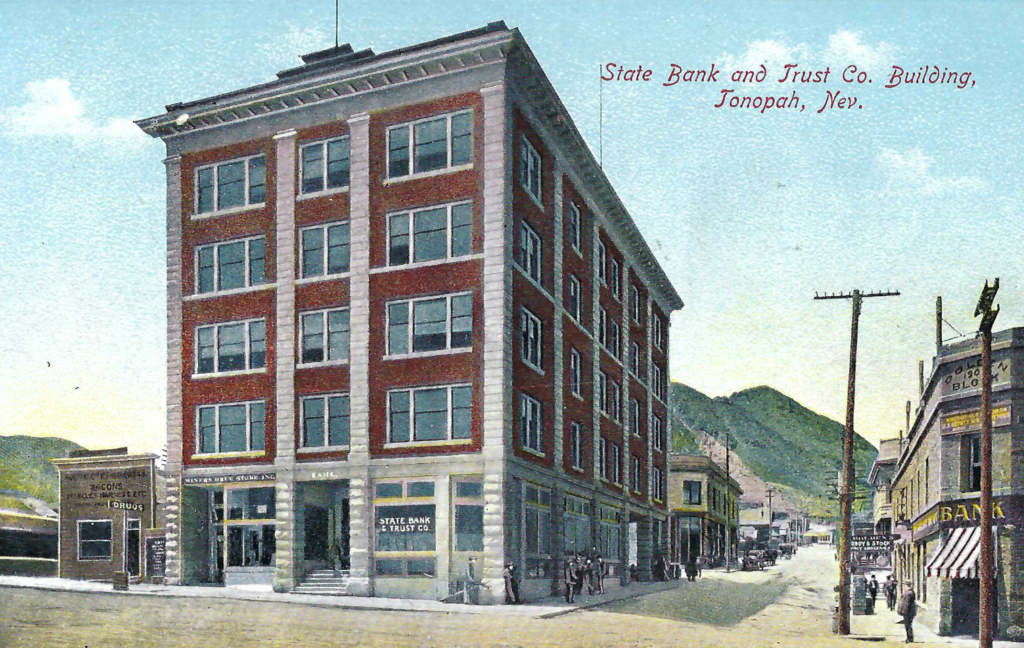
In the State Bank and Trust Company building, just left of the steps is the Miner’s Drug Store. On the right side of the image is the “Golden Block.”
Today the “State Bank and Trust Company” building is alive and well. Located on the southwest corner of Brougher Avenue and Main Street.
The building was purchased in 2011 by Fred and Nancy Cline who spent nearly a decade restoring and renovate the structure now known as the Belvada Hotel. And, today, the building is an operating hotel.
Here is part of the story from the Cline’s website. “The Belvada was built as The Nevada State Bank & Trust building in 1906. The building was erected in Classical Revival style and the Chicago style influence can be seen in the large windows on the first floor. Four months after the building was completed, a nationwide financial panic struck the USA, and the State Bank & Trust building closed. Its owner, Thomas Rickey, was arrested and indicted for embezzlement and the bank closed its doors.”
In 1990 the Central Nevada Historical Society, as part of its membership benefits, would send out 3 and a half by 5 inches photographs of historic sites.
The “Mid-Year 1990 #39” society photograph is a copy of the A.J. 5 post card. The society noted on the back “The photo was reproduced from a rare 1907 color postcard.”
The staff of the Central Nevada Historical Society wrote on the back of the photograph; “The State Bank building was the first five-story structure built in Tonopah and was constructed of brick freighted in on the Tonopah & Goldfield Railroad. The building boasted one of Nevada’s first elevators and housed a bank, saloon and other businesses on the ground floor. Doctors, Lawyers, dentists and other professional rented offices on the upper floors. In later years, these offices were converted to apartments and by 1960 the building was known locally as the Belvada Hotel.”
For the rest of the story, here is the link to the Belvada Hotel web site. https://www.belvadahotel.com/history.html
A.J. 6 Early days in Tonopah, Nev. The scene in view on A.J. 6 is the inside of a saloon with a bar and several men playing cards—a total of fourteen men, including half with mustaches. Two of the men are hiding their faces.
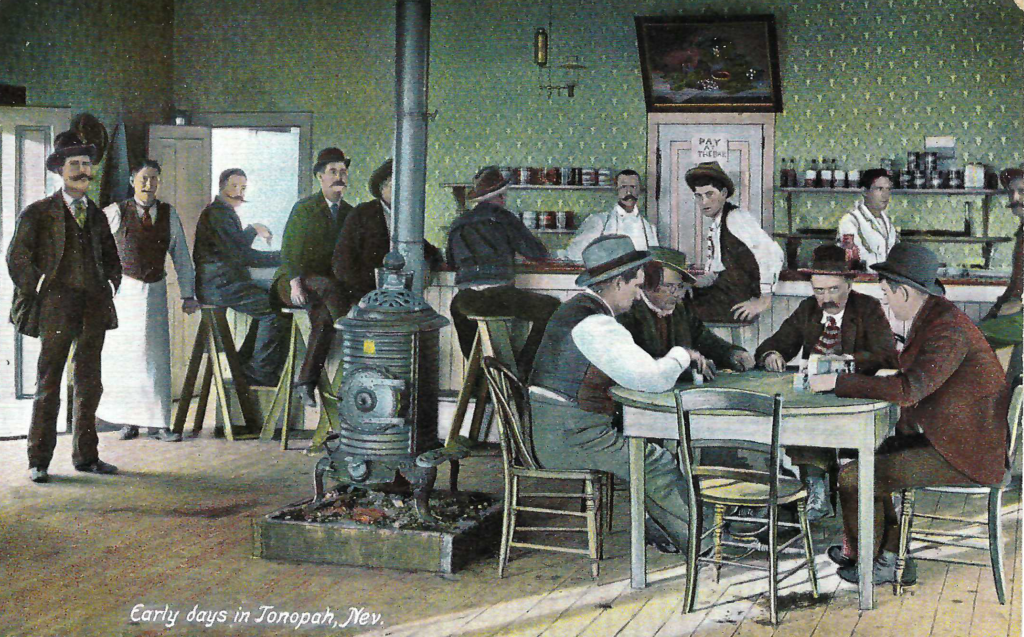
Interesting bar stools
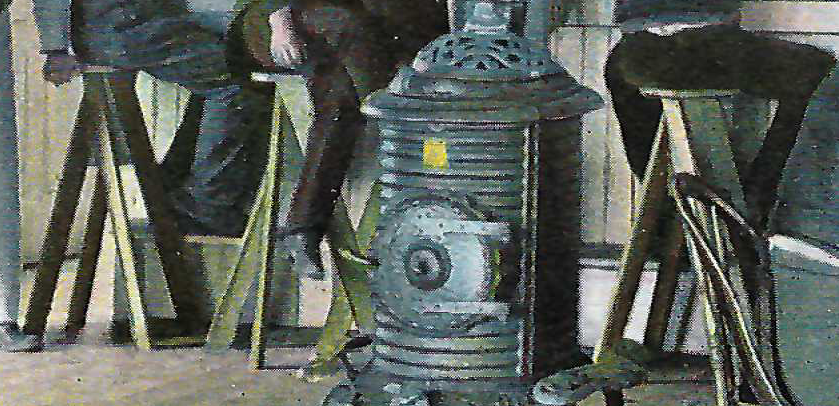
The sign on the door reads “Pay the Bar.”
A.J. 6 is one of two post card in this series with a white title; all other titles are red.
A.J. 7 General View of Tonopah, Nev.
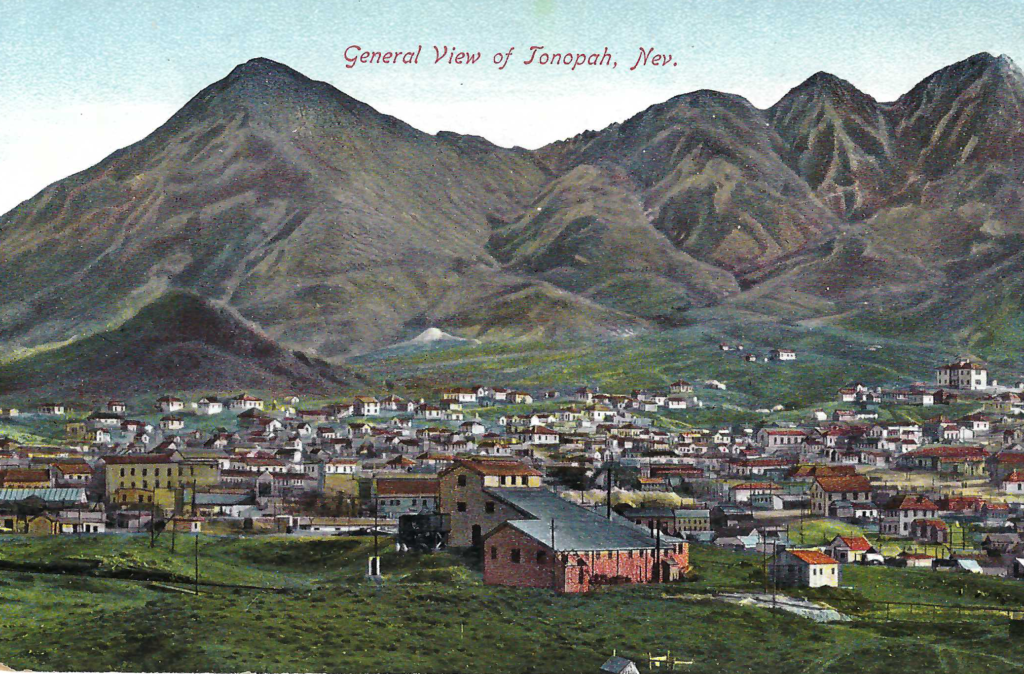
This view was also released by the Newman Post Card Company as number 3 in the 132 series.
A.J. 8 Early Mode of Transportation into Tonopah, Nev.
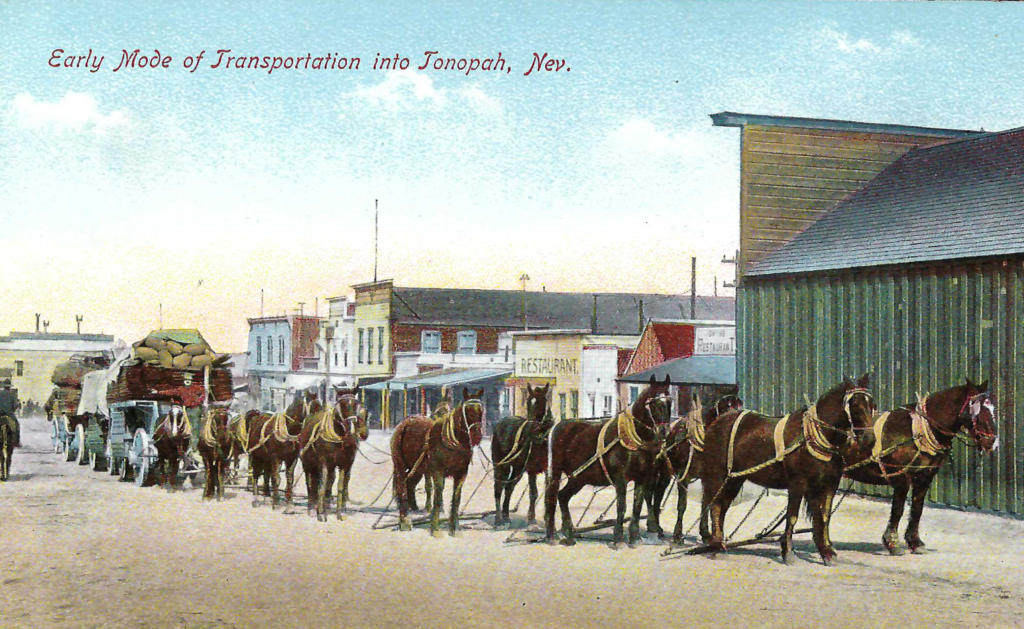
This view is also found in the Newman Post Card Company 132 series as number 8.
A.J. 9 Nye County Court House, Tonopah, Nev.
Until February 1905, the Nye County seat was located in Belmont, but following lobbying by the citizens of Tonopah, Governor John Sparks signed the law that transferred the county government to Tonopah.
A courthouse needed to be built. A contract was awarded and work began in May. The sturdy structure was completed in the fall of 1905.
Ron James, in his 1994 book, Temples of Justice, County Court Houses of Nevada, describes the building as having a moderately pitched pyramidal roof crowned by a dome and eaves that include a classical, molded cornice dressed with dentils. Clustered columns support round arches making this the only county courthouse in Nevada with substantial Romanesque elements.
A colorized printed version of the Nye County Courthouse, released in March of 1906, was based on a photograph taken in the late fall of 1905. The building was finished, but not yet occupied. Photographer was likely E. W. Smith.
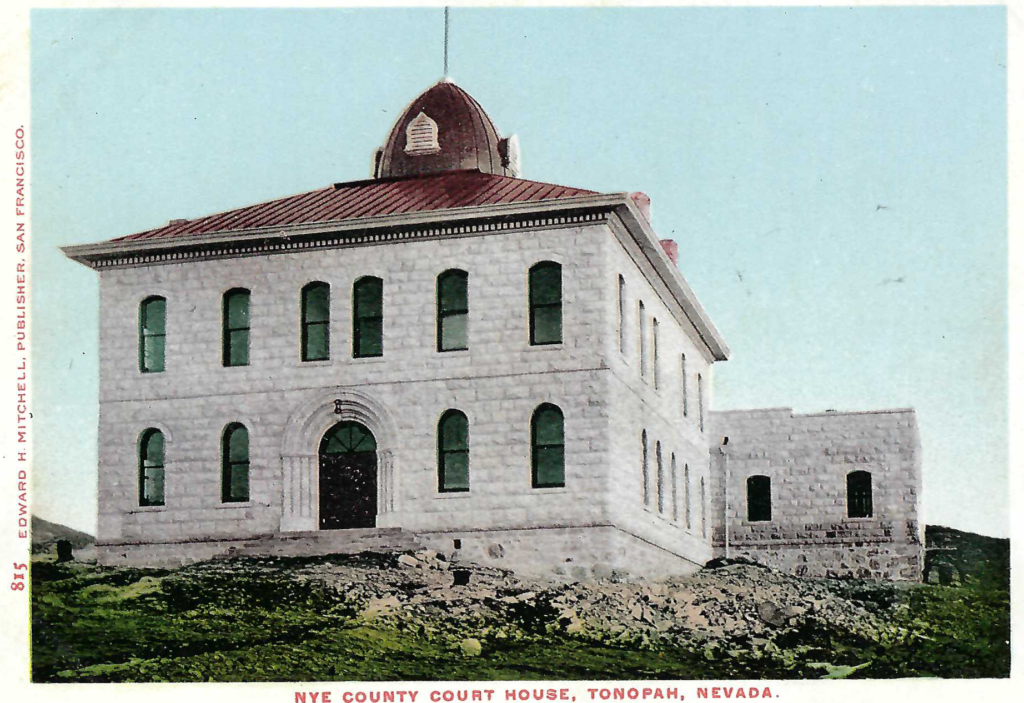
The post card, with an undivided back, 815, was printed by the E. H. Mitchell Company of San Francisco.
The photograph and negative used for the post card were lost in the San Francisco earthquake of April 1906.
A second photograph was taken the same day, but from a slightly different angle was used by Mitchell to produce new post cards of the courthouse. His artists added a U.S. Flag.
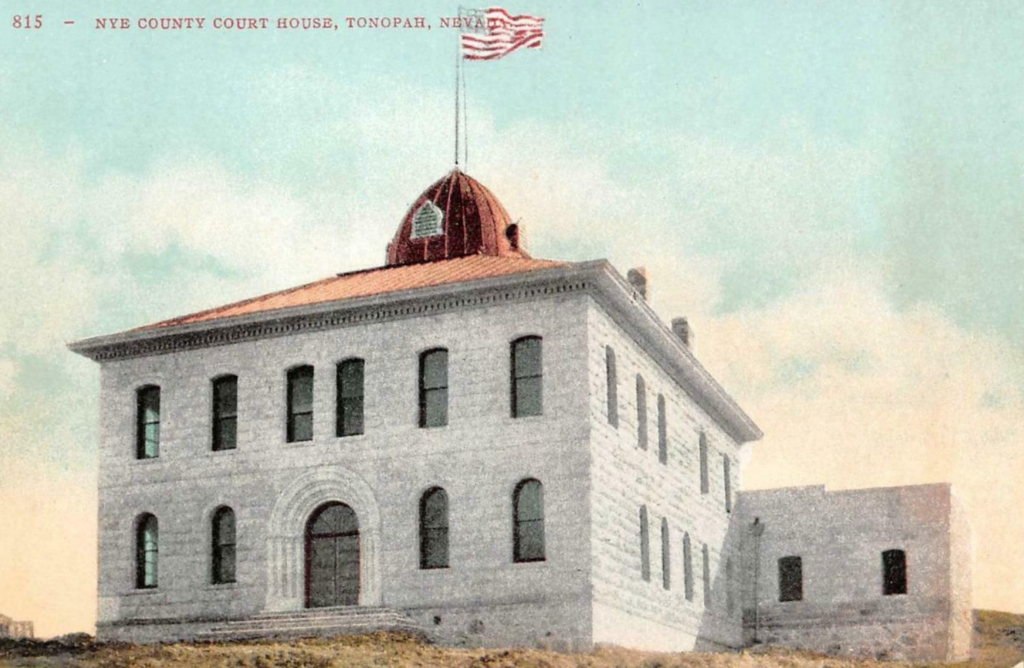
All of the later post card versions, printed in 1907-1910 use the same photograph seen in the second Mitchell 815.
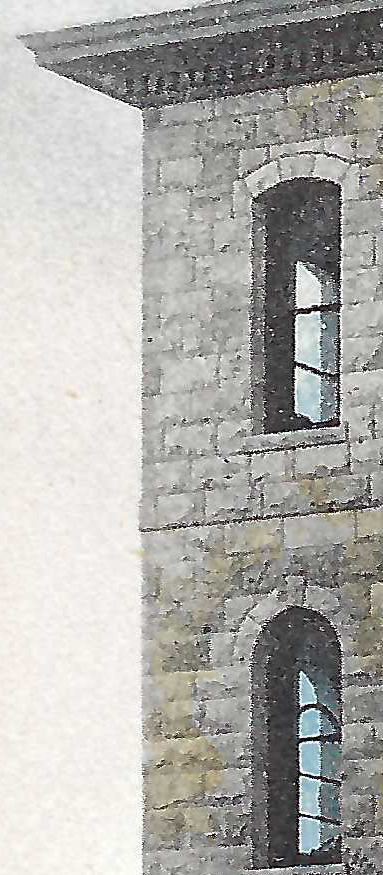
The different post card artists changed colors, eliminated, and added elements to the same photograph.
But, one consistent and interesting visual element of the photograph provides a ‘signature;’ the windows on the front of the building.
You can see through the windows and then through the windows on the left side of the building.
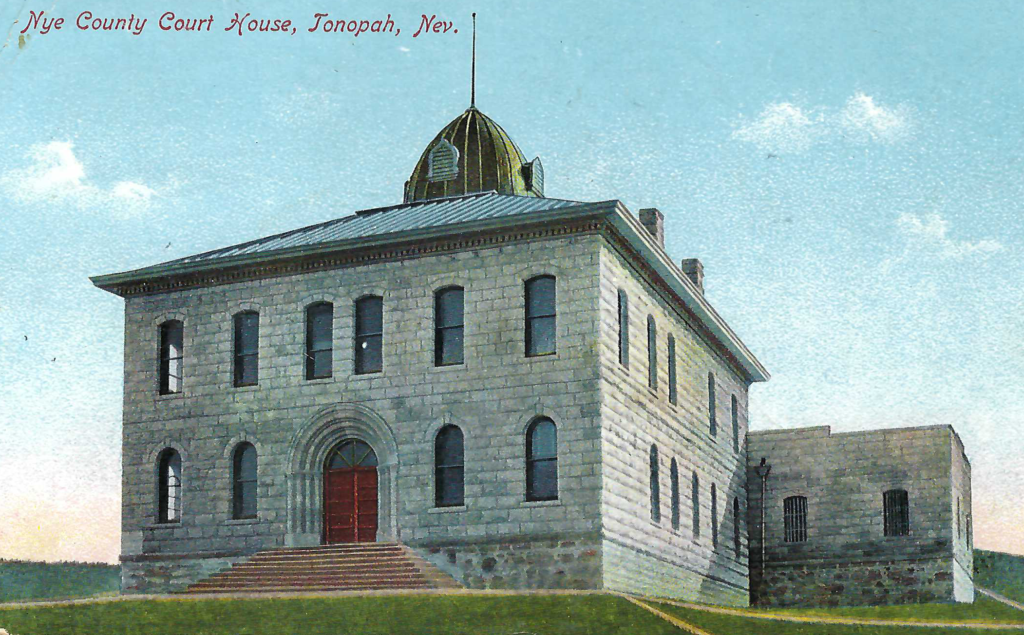
This is the A.J. version of the Nye County Courthouse. Using the same photograph from 1905 artists eliminated construction rubble and added nice, well-kept green lawns. The artist also completed the steps and painted them.
Also eliminated is the small building on the lower-left edge of the image.
But, the artists did not add a U.S. Flag.
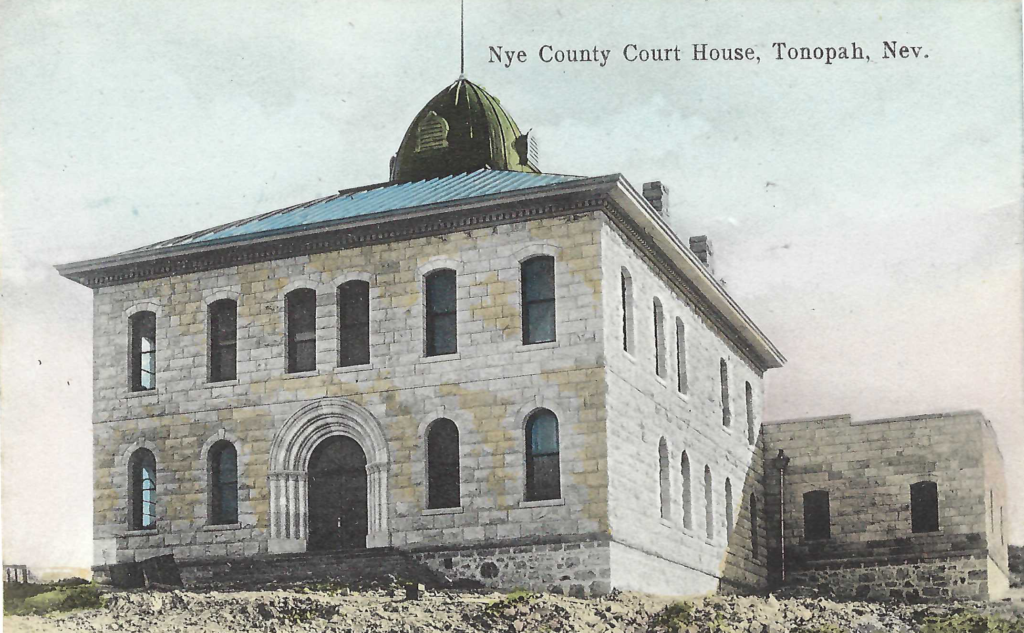
This is post card is from the Newman 132 series, number one. Note the light brown ‘stains’ on front of the building. The flag pole, without a flag, extends beyond the top edge of post card.
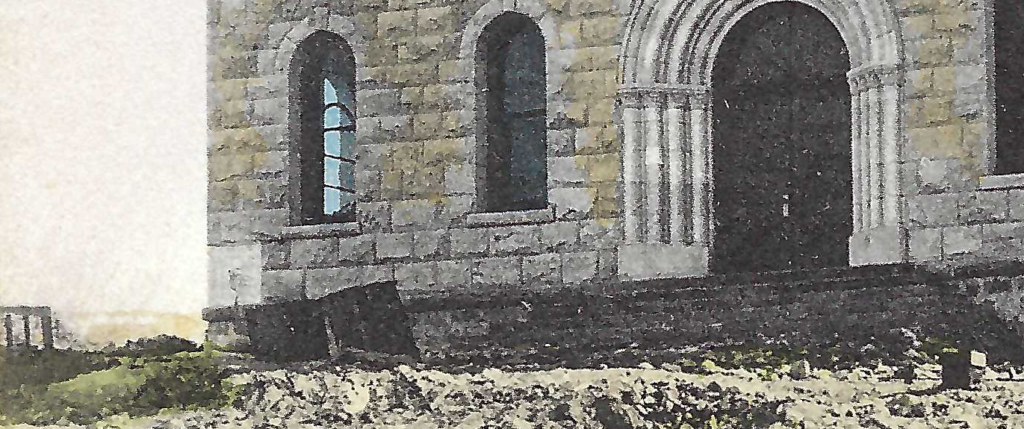
The Newman view maintains some construction elements in the front of the building.
Is that white square seen on all the post cards, the cornerstone?
This view was also released by the Newman Post Card Company as number 6 in the 132 series.

A.J. 11 A Typical prospectors outfit, Tonopah, Nev.
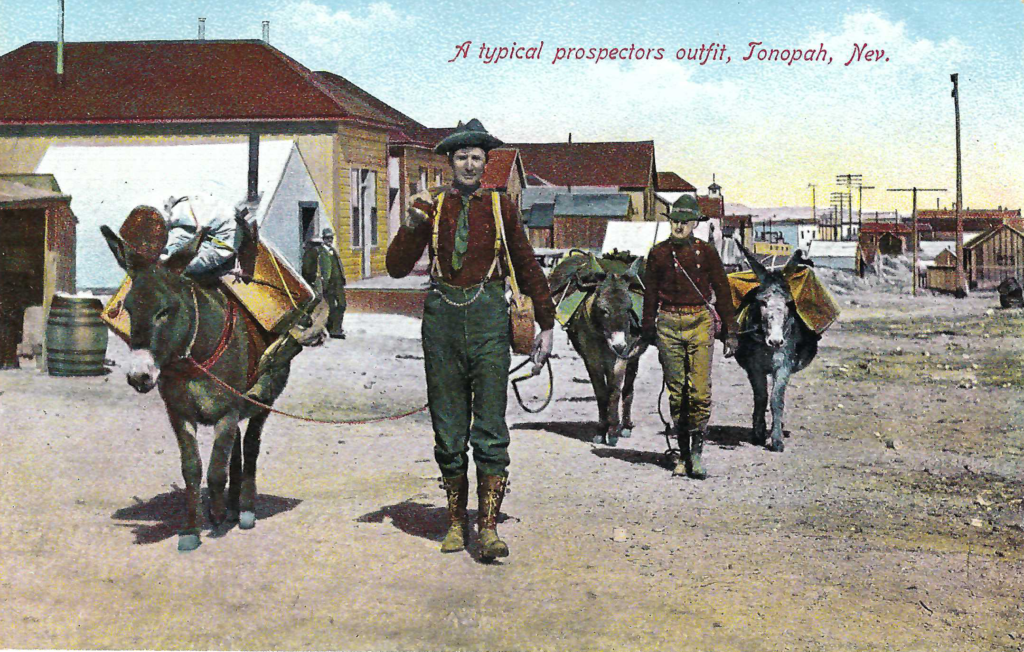
This view was also released by the Newman Post Card Company as number 24 in the 132 series.
A.J. 12 Some of Tonopah’s Residences.
This view was also released by the Newman Post Card Company as number 5 in the 132 series.
Note four residences are visible with a 5th structure, a double duty ‘outhouse’ visible on the ridge behind the homes.
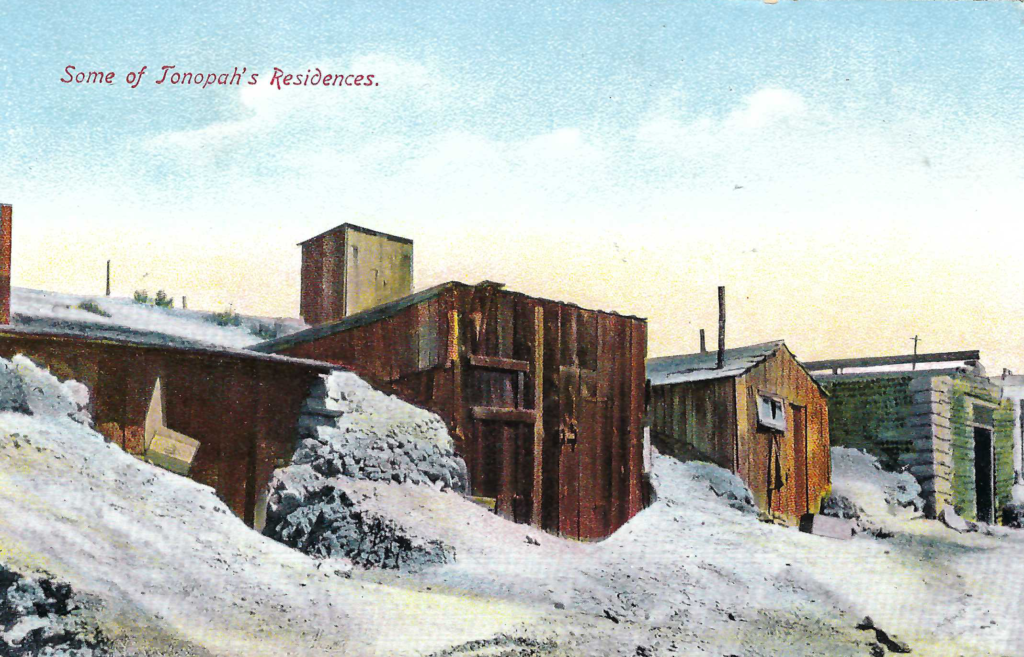
While not the most famous of Tonopah’s bottle houses, a second bottle built homes is visible on the post card’s far-right side.
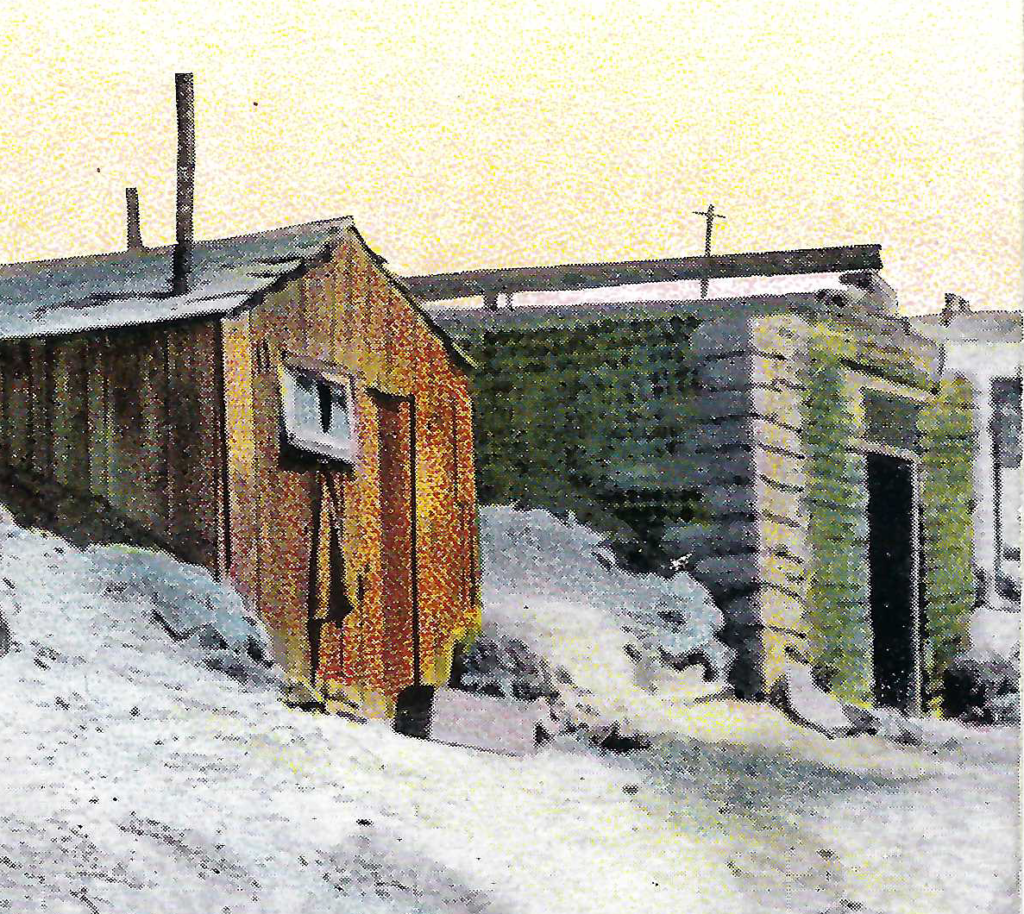
A report issued by the Nevada State Historic Preservation office states between the fall of 1900 and December 1901, the majority of the Tonopah population were miners whose attention was focused on the exploration of the mines, little effort was spent on any substantial building activity, and the provision of the shelter was only a matter of expediency and availability of materials. Structures consisted of a conglomeration of tents, dugouts, board and batten dwellings, and crude stone cabins, as well as a variety of makeshift efforts such as wood and gunny sack houses, barrel and bottle houses, houses of packed mud, or any combination of materials which could be assembled to provide shelter.[i]
A.J.13 Loading Ore at Montana-Tonopah, Nevada, Mine.

A.J. 14 Public Library, Tonopah, Nev.

This is the AJ version of the photograph of the public library. Note the x upper left of the post card. Photographer, unknown, was looking west when the photograph was taken.
The “x” on the left side of the post card was made by Isadora Horton. She wrote from Tonopah to her friend in New York on January 12, 1912 “The stone used in this building was quarried near here. Under the cross is a small cabin, where some prospectors lived while prospecting for gold. From my house, it looks as if it were hanging onto the side of the mountain.”
A widow, Mrs. Horton arrived in Goldfield in 1906 with her two-year-old son Thomas. Why she came to Nevada at the age of 45 is not known at this point. Horton later moved to Tonopah where she became a leader in the suffrage movement. Eventually, she moved to Reno where she died in 1934.
This view was also released by the Newman Post Card Company as number 28 in the 132 series. In this case, the 132 series has a more realistic detailed image.
The 132 version gets the nod for the better selection of realistic colors, and the nod for detail, especially the background on the left side of the view.
The artist working on the A. J. version erased a post visible on the left side of the Library, seen in the 132 version.
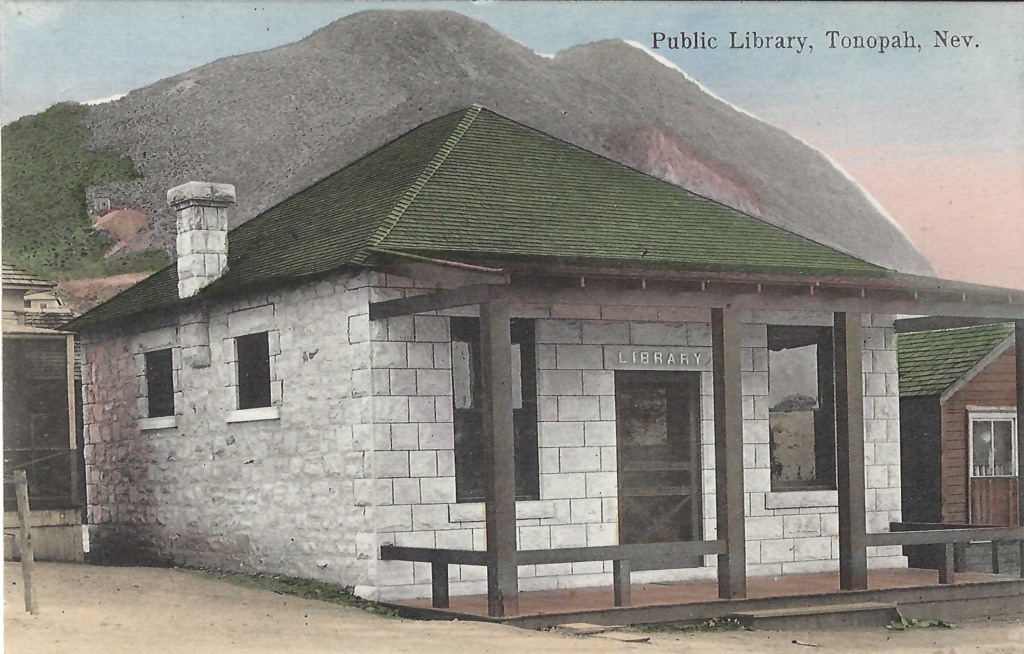
The building, completed in January of 1906, still stands.
More details are found at https://www.tonopahnevada.com/tonopahlibrary/ And, https://npgallery.nps.gov/NRHP/GetAsset/NRHP/82003252_photos
A.J. 15 High School, Tonopah, Nev.
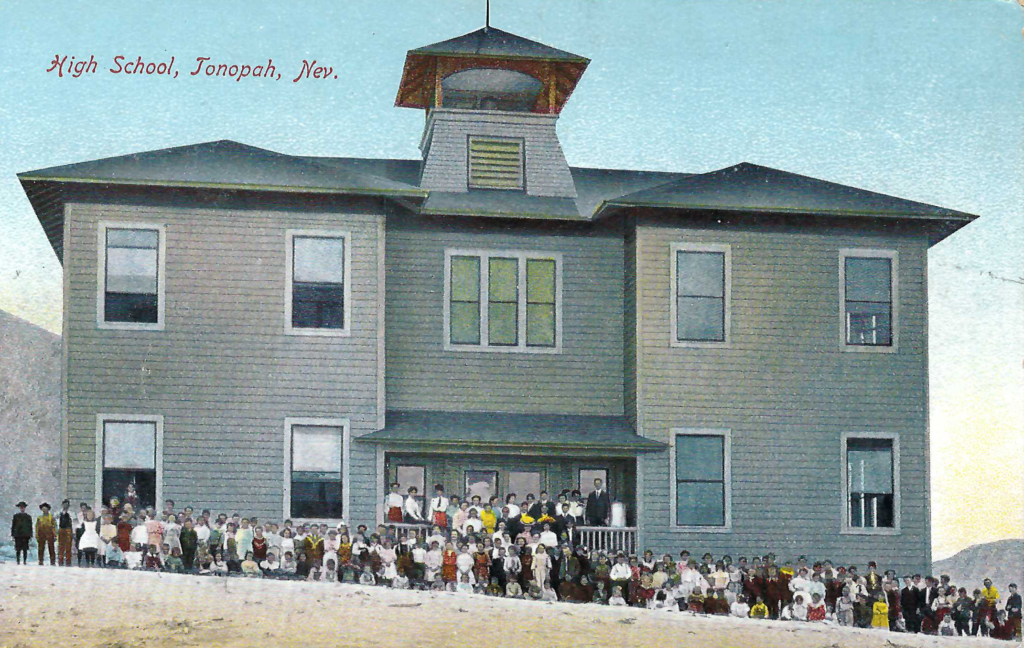
This view was also released by the Newman Post Card Company as number 7 in the 132 series.
A.J. 16 The Can House, Tonopah, Nev.
Photographer H. T. Shaw took this photograph of the “can house” in late in 1905.
Like the bottle house, and the barrel house, the Can House of Tonopah was popular with post card buyers and used many times, for several years, by different post card publishers for several years.
A U.S. government report on the historical details of Tonopah states the distillate oil cans became a common building material in Tonopah. When filled with sand, the cans could be laid like a brick; if flattened out and nailed like shingles, it served as a roofing material. [ii]
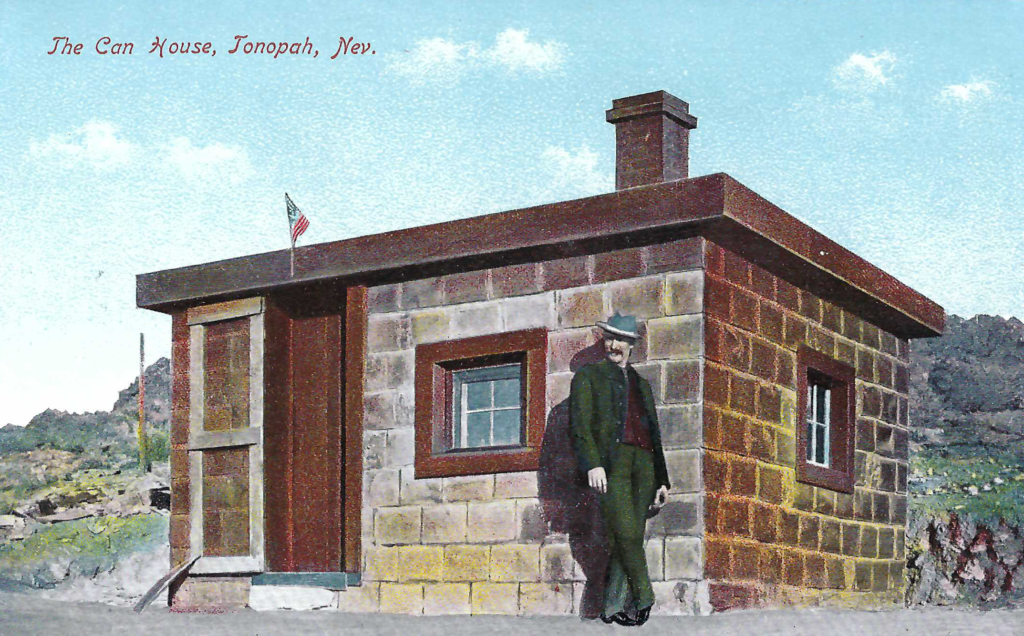
Tonopah photographer H. T. Shaw released his photograph as a postcard with the hand-printed title CAN HOUSE TONOPAH, NEV. NO. 5 PHOTO BY H. T. SHAW
As is often the case, the p is written backward.
Shaw’s photograph shows the U.S. flag above the door.
No clouds are visible in Shaw’s black and white real photo post card.
The photograph, used for A. J. 16 was first used on a colored E.H. Mitchell post card, printed in early 1906.
It is not known if Mitchell purchased or borrowed the photograph from Shaw. Since these post cards would be solid in the Tonopah market, it is likely Mitchell purchased the rights to the image from Shaw.
The U.S. flag is gone from Mitchell’s undivided back version. The small pole on the edge of the roof that held the flag is visible.
There are no clouds in Mitchell’s undivided back version.
When Mitchell printed a divided back version of this photograph, the U.S. flag re-appears, and clouds were added.
The Newman, A. J. 16 version of the photograph includes the U.S. flag and clouds. In Newman’s version, the artists scattered the clouds.
Newman released another version of this photograph in his 132 series. The title of 132/27 is The Can House, Tonopah Nev.
A green desertscape, a drab brown color selected for the cans, and a colorless U.S. flag are visible, as is a new set of clouds.
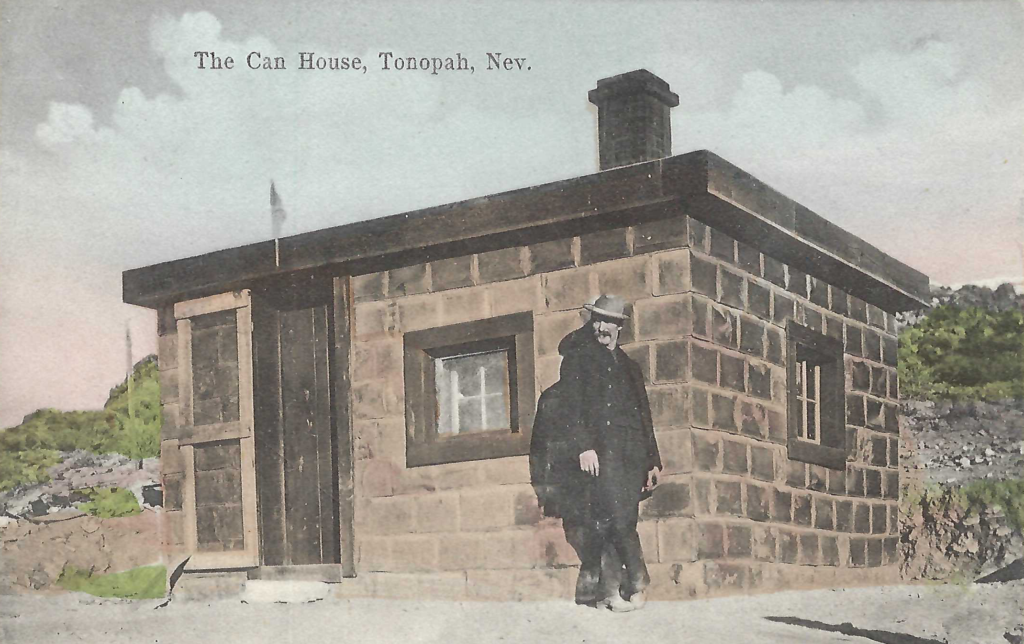
A.J. 16 The Can House, Goldfield, Nev.
In a later printing, Tonopah, Nev. is covered up by red ink, and Goldfield, Nev. is printed just below, in red ink.
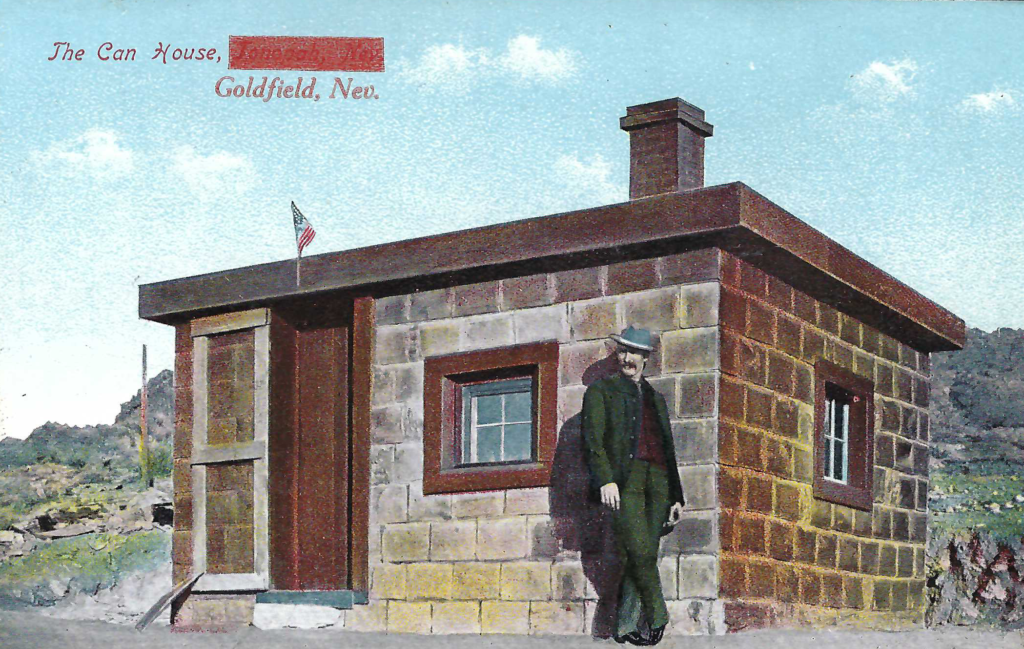
A.J. 17 The famous bottle house, Tonopah, Nev.
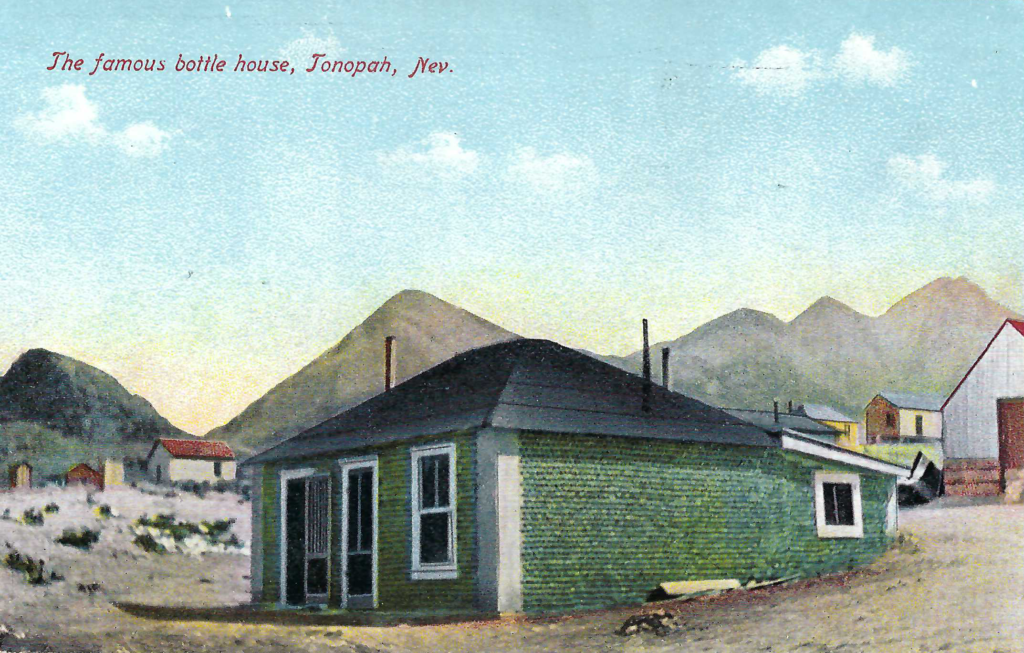
A nice side view of the “Famous” bottle house. The artists work on this post card, like several post cards in the A. J. series has an oil painting feeling.
A.J. 18 Burrow fast express, Tonopah, Nev.
While no photographer has been identified, the title leads to the possibility this is the work of P.E. Larson.
Is the spelling of “burrow” part of the humor or just a mispeclling?
Photographer unknown. However, the staged image and caption which has the earmarks of Larson’s humor, the photograph was likely taken in Goldfield.
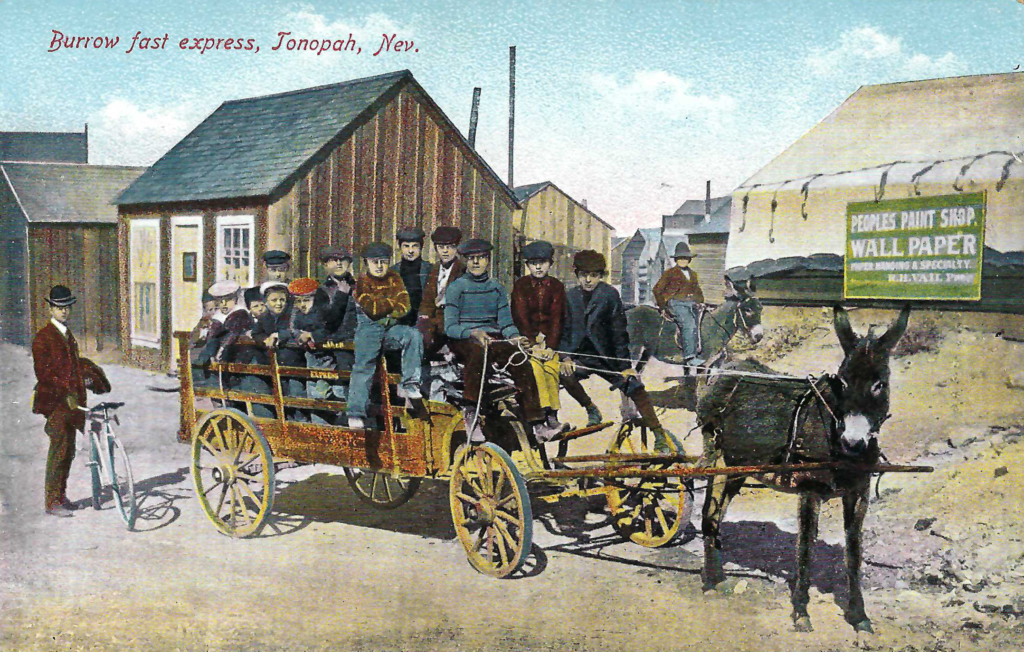
Thirteen pre-teen boys, all wearing caps, are in a wagon with lettering on the side of the wagon. The lettering appears to read “—-aper Express.
Likely the boys are newsboys on a wagon called the Newspaper Express. An older boy holds the reins on the one donkey pulling the way. Two men, one with a bicycle and one on a burro, are seen on to the right and left of the wagon.
To the right is a large tent with a wooden sign, PEOPLES PRINT SHOP WALL PAPER PAPER HANGING A SPECIALTY R. B. VAIL Prop. On the building directly behind the boys in the wagon is a large sign with hand, likely palmistry operation.
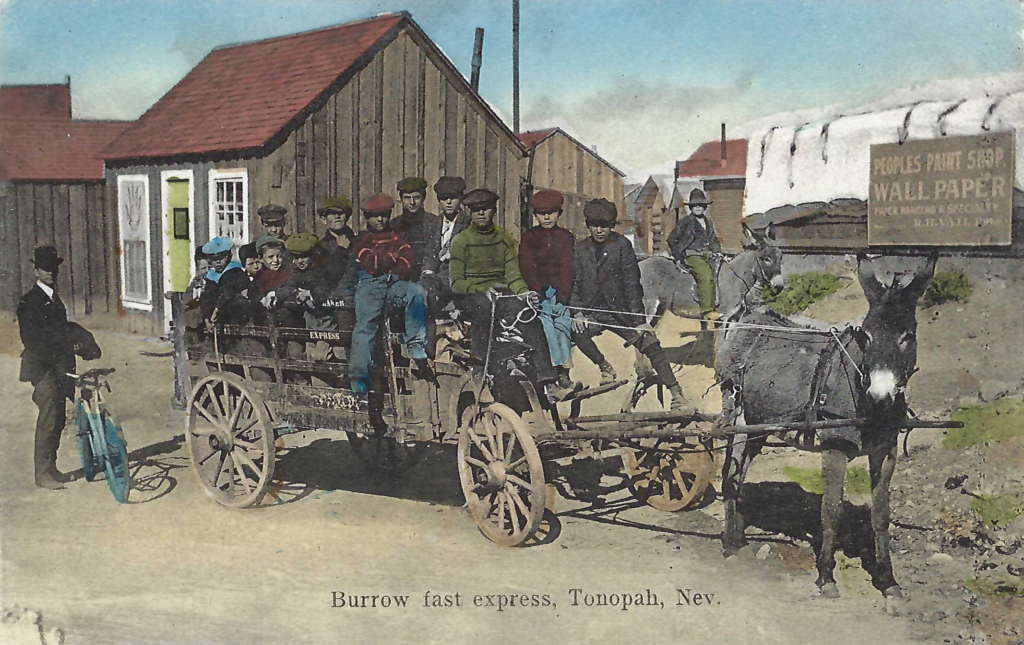
This is the Burrow fast express produced in 1907 by Newman in the 132 series.
The details in both the first printing in 1907 for the 132 series, card 25, and the second A.J. series, card 18 are very similar, with one major exception.
Several of the boys faces in the A. J. version are distorted, mask like and created by the artist. On the other hand, the faces in the 132 series, card 25, look more like a photograph.

This is a close up of the boys faces on card 25 in the 132 series.

A.J. 18 Burro fast express, Goldfield, Nev.
On the second version of this view, Tonopah, Nev. is covered up by red ink, and the Goldfield, Nev. is added to the title.
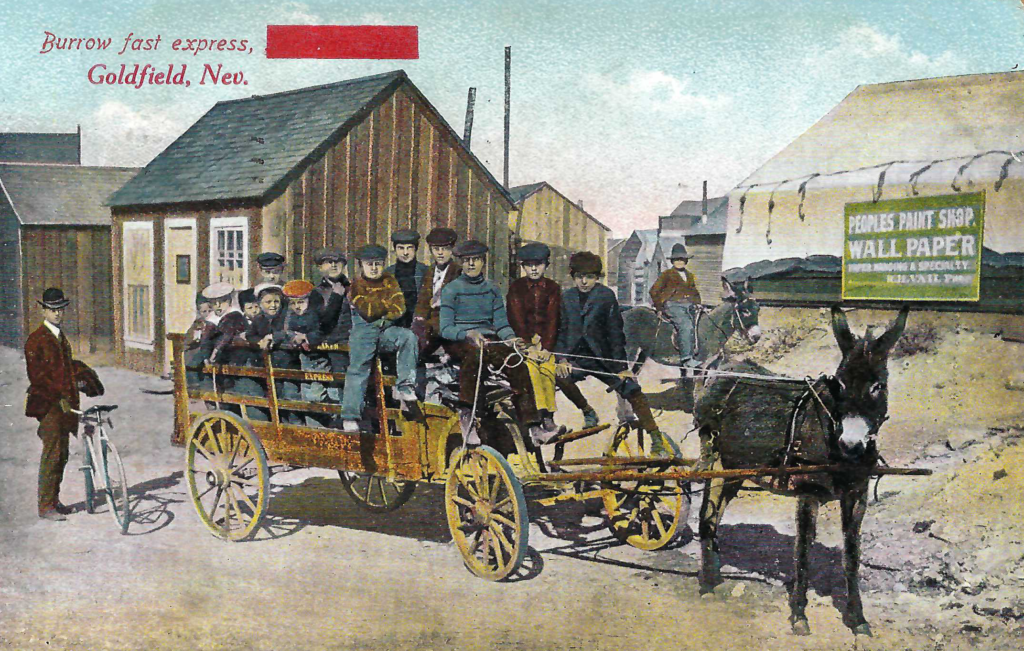
A.J. 19 That which makes Tonopah Nev. famous and prosperous.
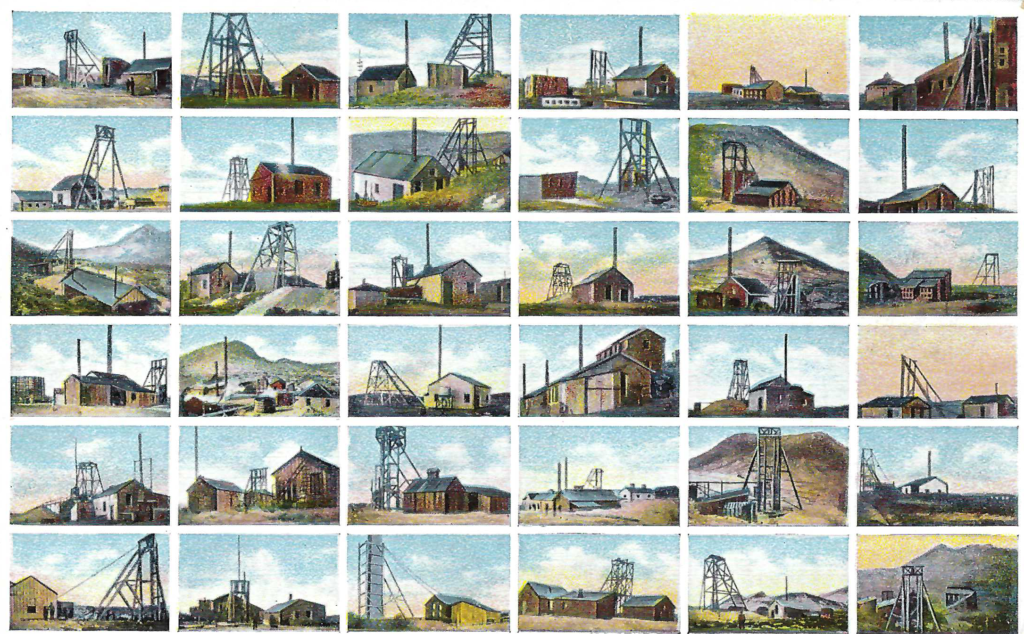
All thrity-six panels on the post card are exterior views of mining operations. The title to the images is found on the left side of the card’s back.
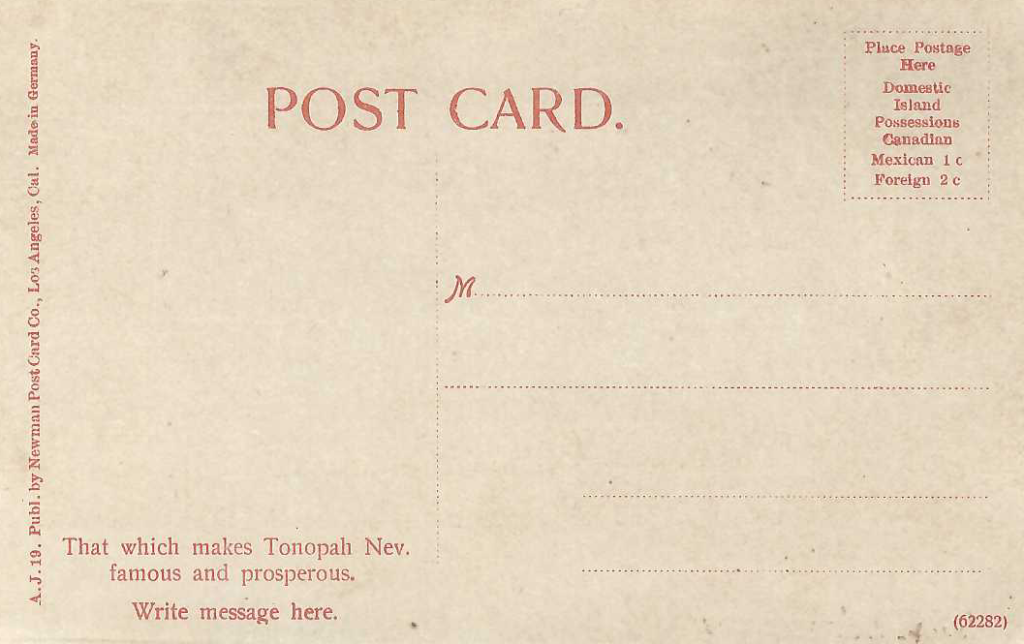
This multi-view was also released by the Newman Post Card Company as number 12 in the 132 series. The same title is used but moved to the face of the post card, center bottom.
A.J. 20 Barrel House, Tonopah, Nev.
The Tonopah Barrel House was a popular subject for many photographers including E. W. Smith.
There are several different post card views of the barrel house, including one in the A. J. series.
The photograph used for the A. J. series was also used by Newman in his 132 series.
In addition, the same photograph was for a Gray News Compay post card. And, while the details are strong in the A.J. version, a bit of artistic liberty is on view. (especially the green for the landscape, including Mt. Oddie in the background).
Visible in the A.J. version is the printing on the wooden boxes used as part of the house’s construction material. One sign reads in part “THE GREAT TONIG—“
The sign to the right of the windows reads “C. CIGA—.”
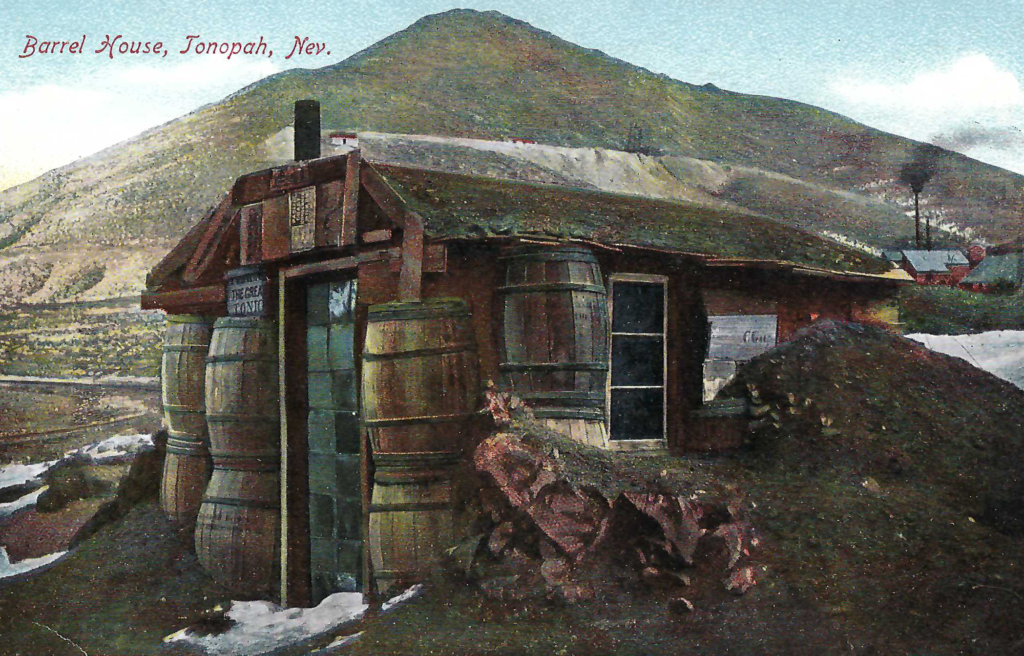
This is the A.J. version of the “Barrel House, Tonopah, Nev.”
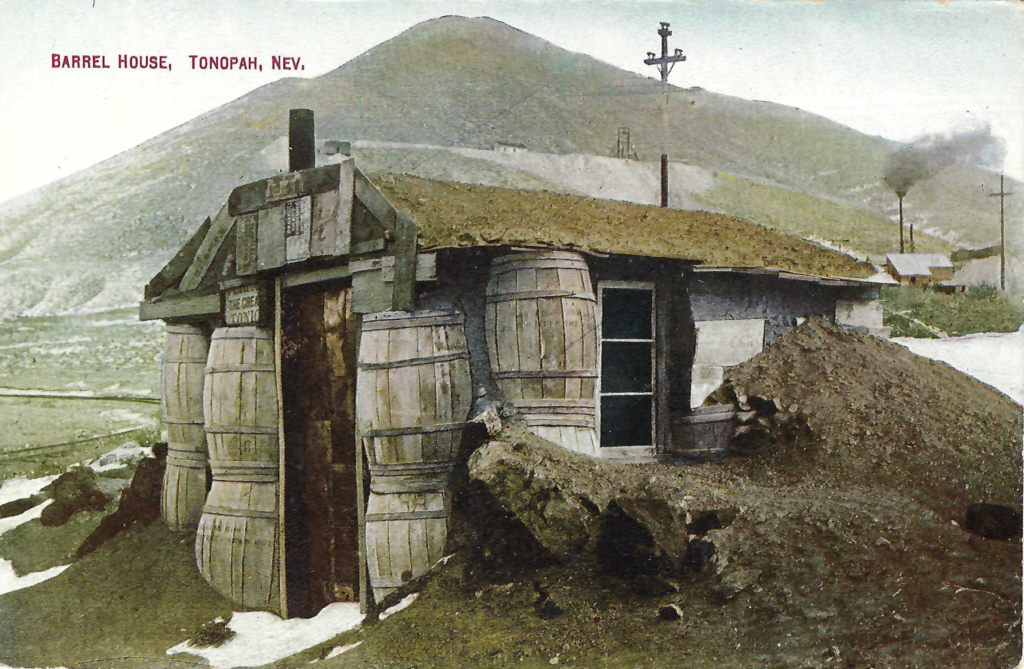
This is the Grey News Version, 4009. Note, telephone/power poles?
Before the A.J. and Gray news versions were produced, Newman released the same photo of the barrel house for use as the 9th card in his 132 series.
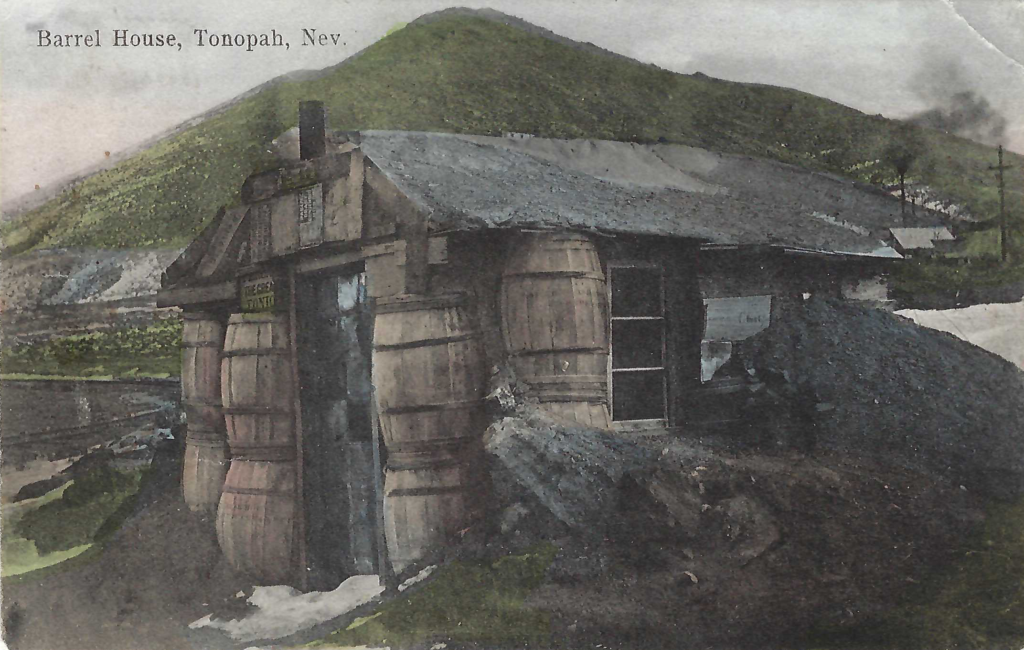
This is the version of the Barrel House in the 1907 Newman 132 series. Hills and landscape green, but one pole on right saved. Overall, the details are soft and the color decisions limited .
The Dennison (Denison) News Company, using a different photograph, also produced a post card of the barrel house.
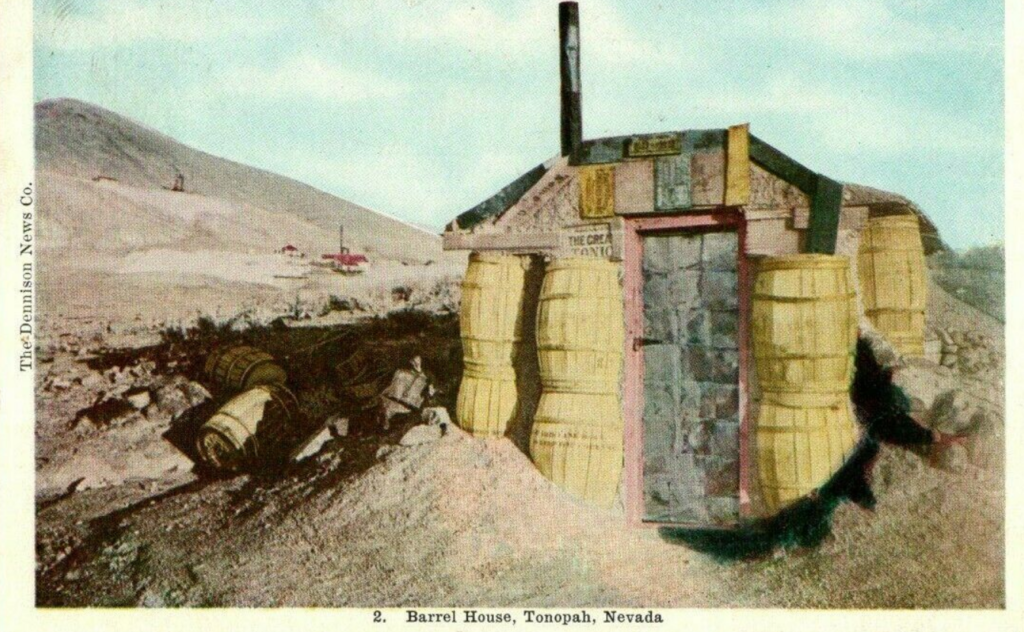
Note the length of the smokestack as well as the barrels on the left side of the house.
E.H.Mitchell released post card of the barrel house. Based on the dog in the photograph this is likely the word of pioneer Tonopah photographer E. W. Smith.
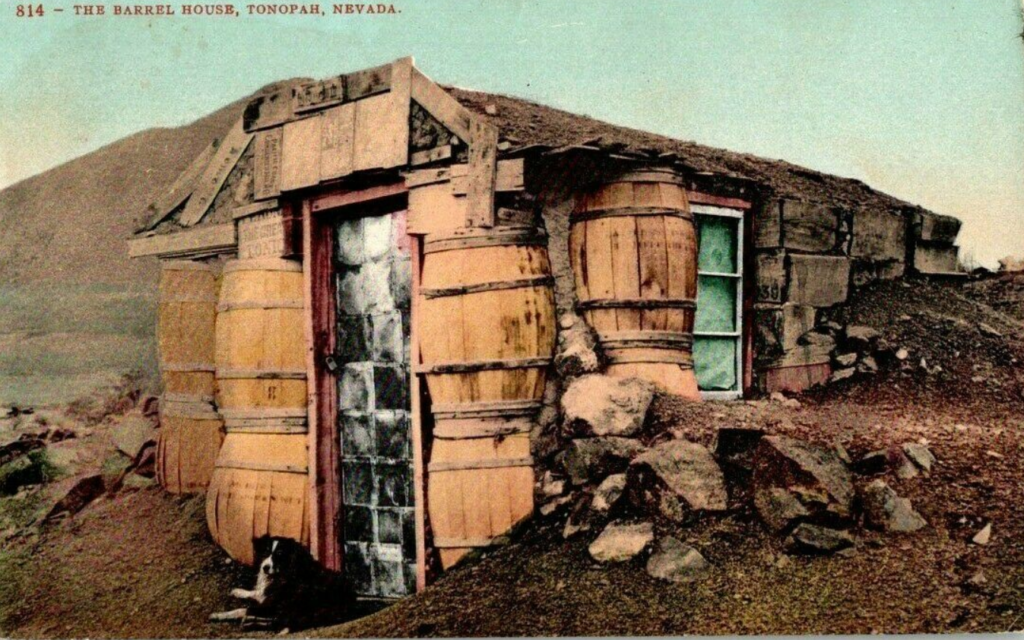
A.J. 21 A Dugout, Tonopah, Nev.
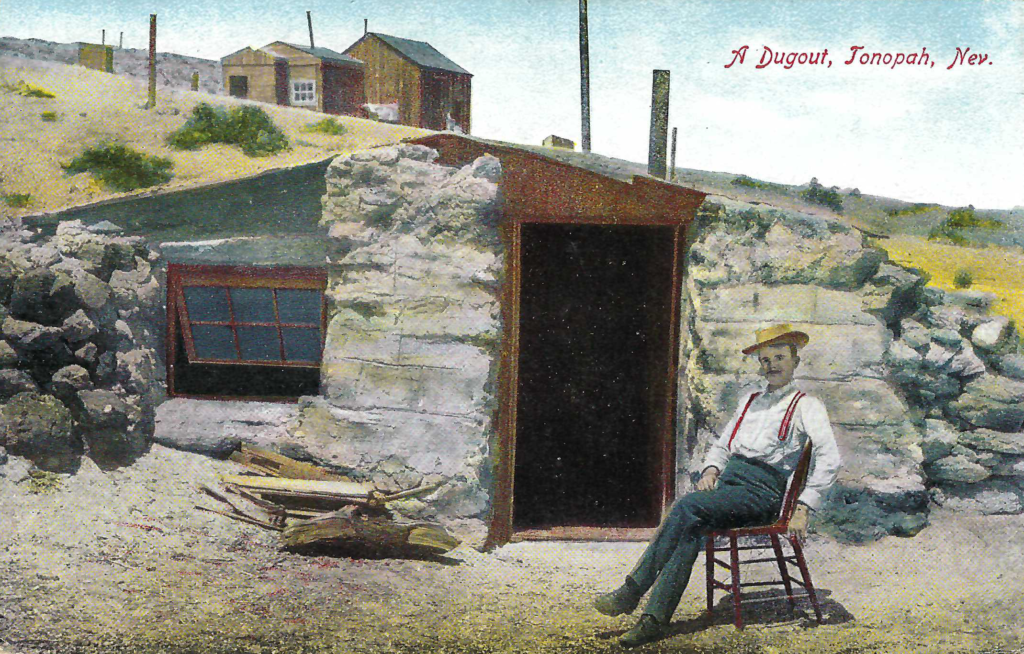
This is the A. J. Newman 1908 release of “A Dugout, Tonopah, Nev.”
From the buildings on the hill to the face of the man with the cigar sitting on the chair in from of his home, the details visible on the A.J. release are superior to the 1907 Newman post card.
The rocks, along with the man’s suspenders turn blue in the 132 post card and the landscape is too green for the Tonopah groundscape.
Martha, who was living in Tonopah, wrote her sister in Sacramento on February 22, 1908 “Fine weather” in Tonopah “until last night it snowed more to come.” Martha also wrote across the front of the 132 Newman post card version, “I don’t know where the grass came from.”
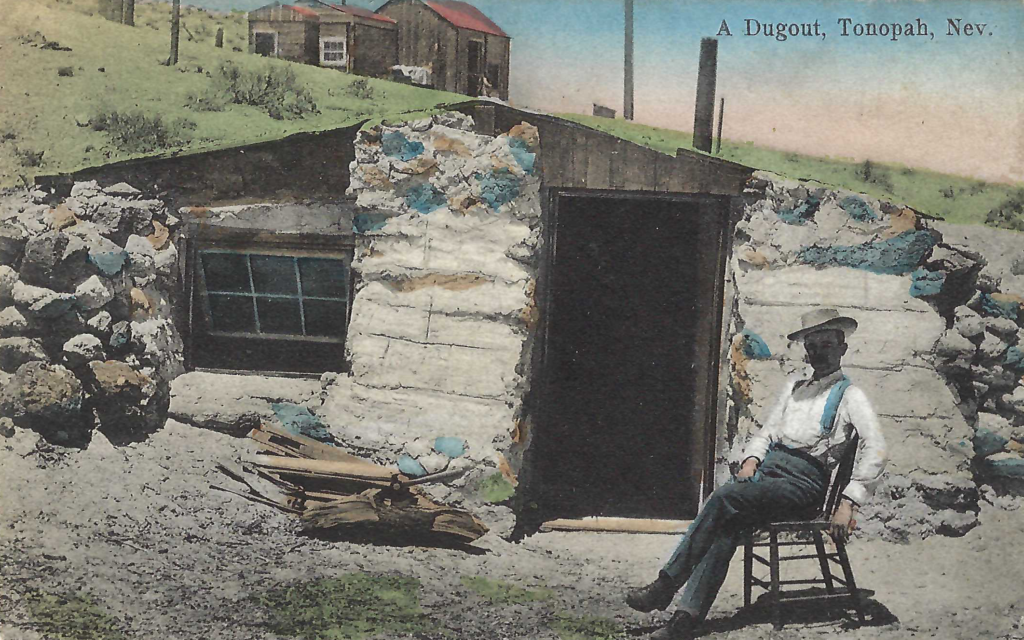
This is the 1907 Newman 132 series release of “A Dugout, Tonopah, Nev.”
A.J. 21 A Dugout, Goldfield, Nev.
The second A. J. version of this view has the words Tonopah, Nev. covered up with red ink, and Goldfield, Nev. printed below.
Why? What was the market for the overprint post cards? The people of Tonopah and Goldfield knew where the “Dugout” was located.
It should be noted, the location ‘battle’ for both the dugout, and barrel, and bottle houses of Tonopah was not limited to the work of Newman.
That story will be featured in aother report.
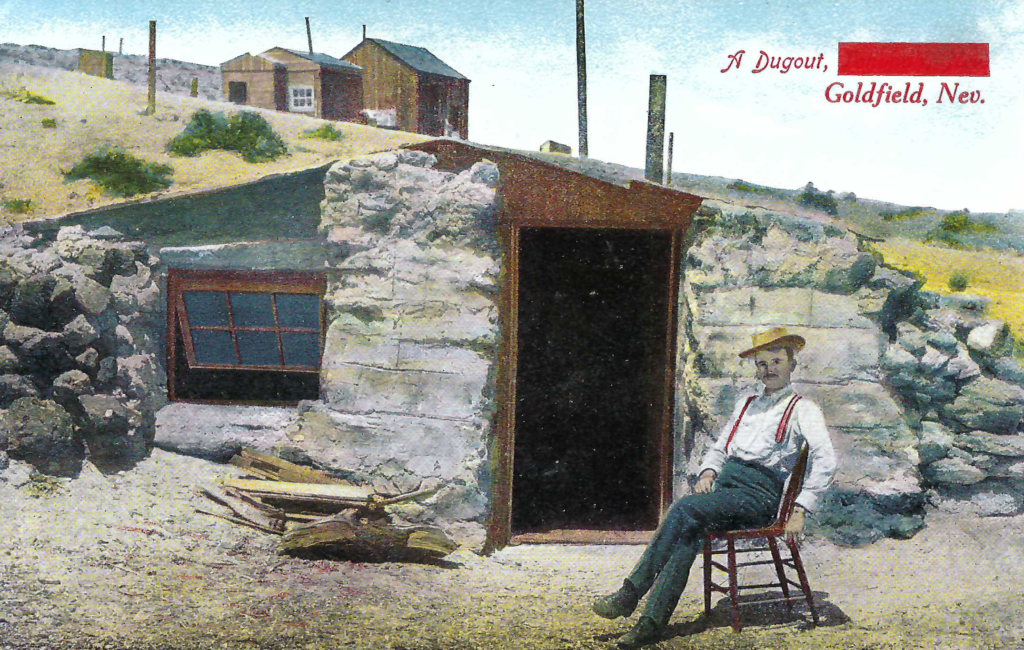
A.J. 22 Mt. Oddie and principal Mines, Tonopah, Nev.
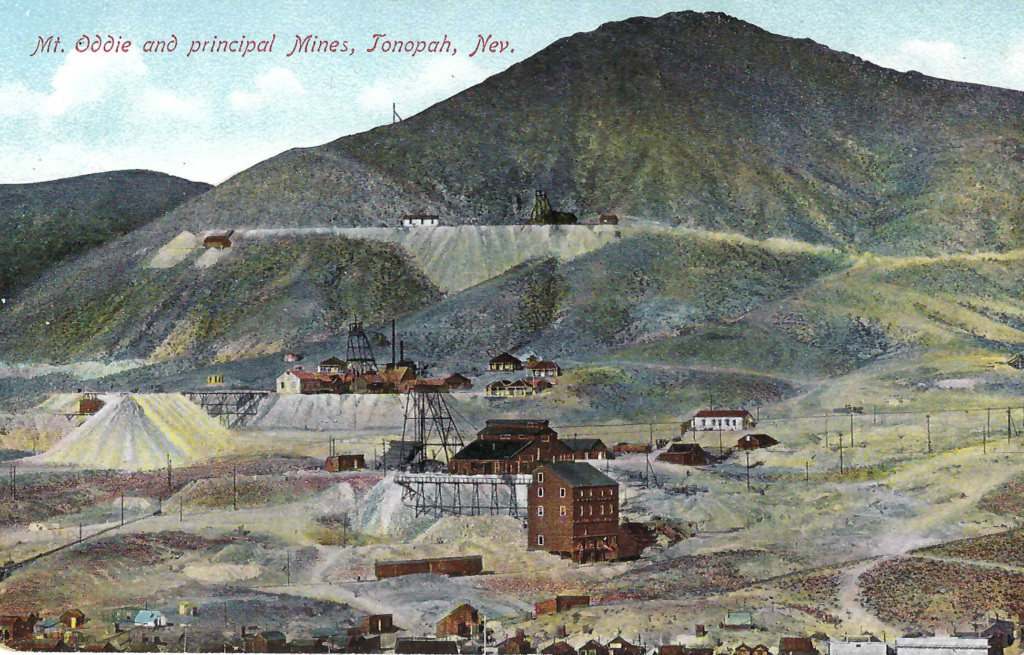
This is the A.J. 22 version of Mt. Oddie. The color choices and details are about equal in the A.J. and the 132 versions. The A.J. artist added clouds.
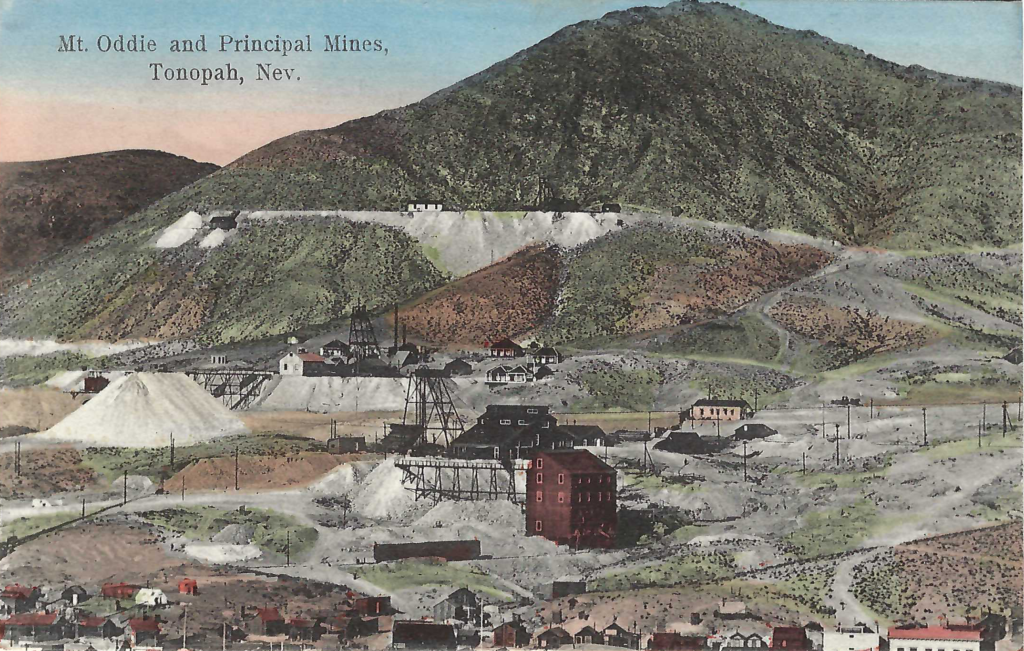
This is number 26 in the 132 series also released by the Newman Post Card Company.
. The 132 version does get a plus as more of the detail of the community is visible along the post card’s bottom edge.
No clouds were added in the 132 version. Instead, there is a sunrise/sunset orange color behind the mountains on the post card’s left side.
A.J. 23 Cloud Effect on the Desert.
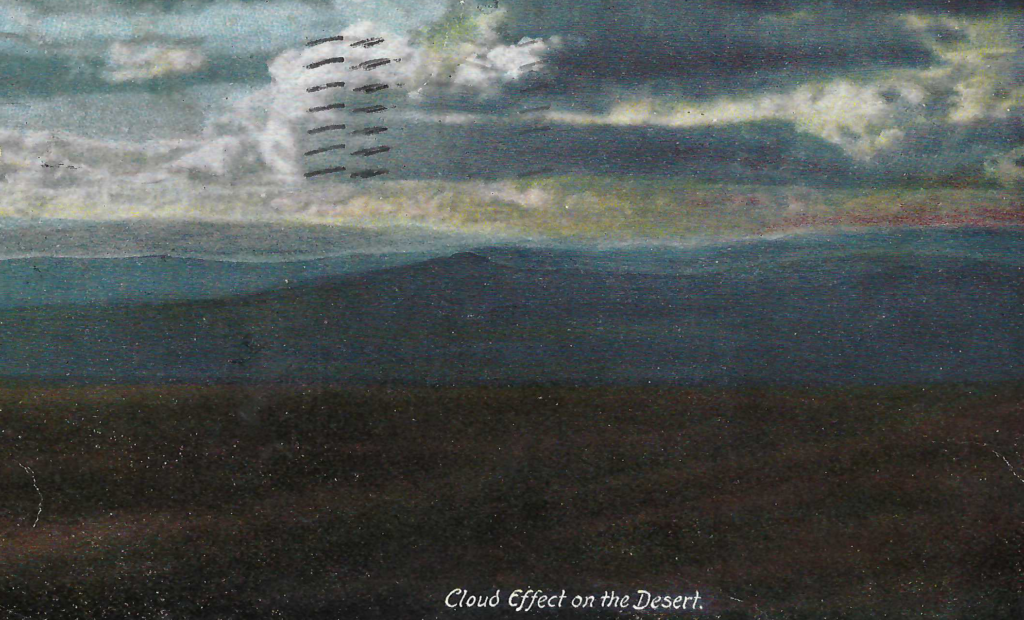
This is the A. J. version titled “Cloud Effect on the Desert.”
The color choices resulting in clarity of detail is lacking in this A.J. post card.
Due to the darkness of the image, this is the second of two post cards in the A.J. series where the ink color for the caption is changed from red to white.
The same photograph of the clouds was also released by the Newman Post Card Company as number 18 in the 132 series. The caption was expanded to read, Cloud Effect on the desert near Tonopah, Nev. and is printed with black ink.
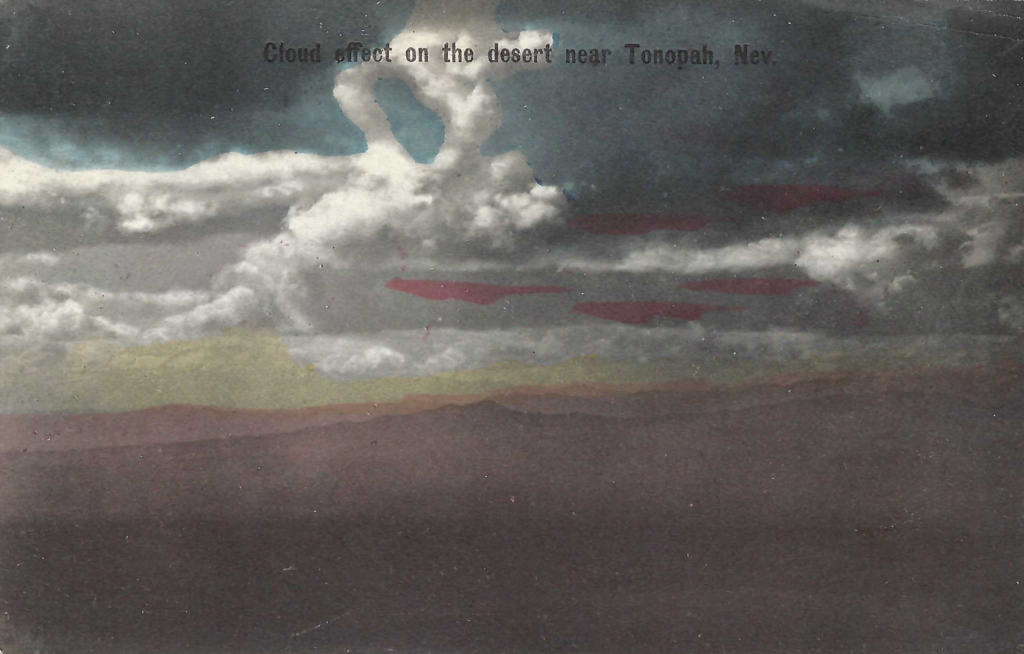
Beyond the title and color changes, the most important difference between the two versions is the cropping changes made to the original photograph.
Eliminated from the A.J. version is the important oval hole in the storm clouds.
Neither the 132 nor the A.J. version get high marks for color decisions.
However, the 132 version gets a positive nod because of the cloud detail and the fact the caption includes a location.
A.J. 24, 25 and 26
While there are three additional post cards, numbered A. J. 24, 25, and 26, the views are not part of the original Tonopah series.
The three post cards featuring views of the state, distant from central Nevada, were printed separately from the other cards in the A.J. series.
The views are from the eastern and southern parts of the state.
Also, the backs of A.J. twenty-four to 26 are different from the first twenty-three post cards, indicating the cards were printed at different times.
A.J. 24 and 26 are views of Palisade Canyon located in Eureka County in northeast Nevada, about ten miles west of Carlin. Palisade was a small town located in the canyon. The town served nearby mines for many years, and to this day, the railroad still runs through the canyon.
A.J. 24 Palisade Canyon, Nevada.
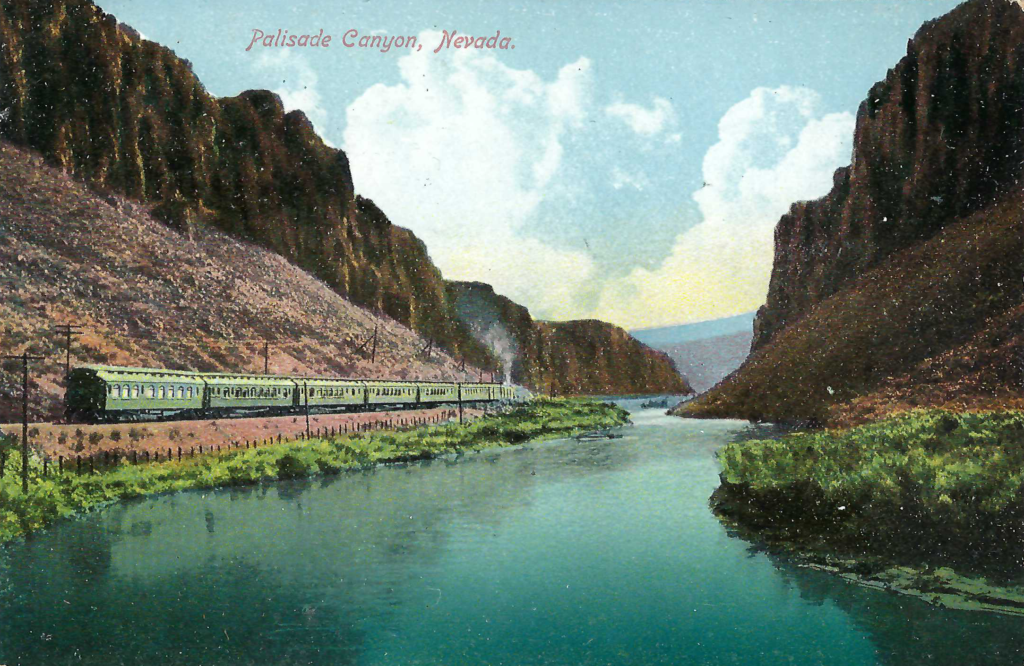
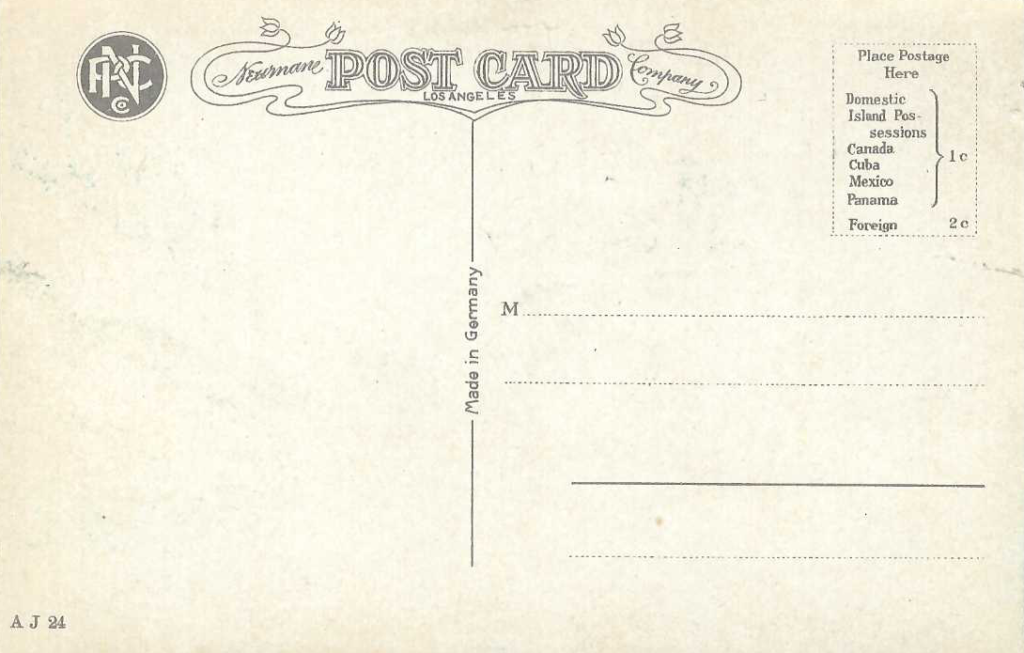
A.J. 25 The Los Angeles Limited in Rainbow Canyon, Nev.
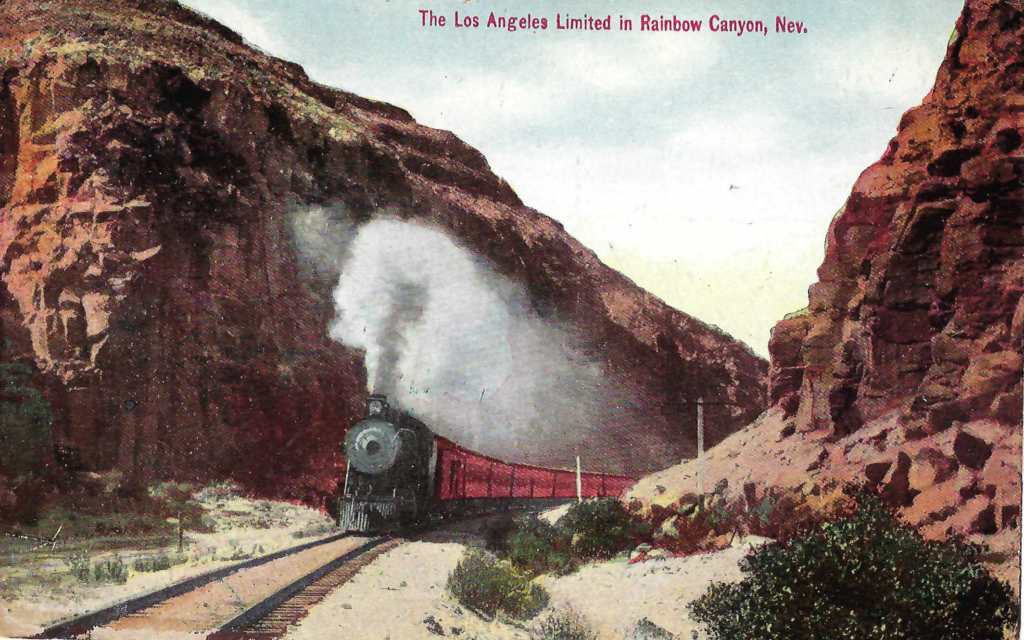
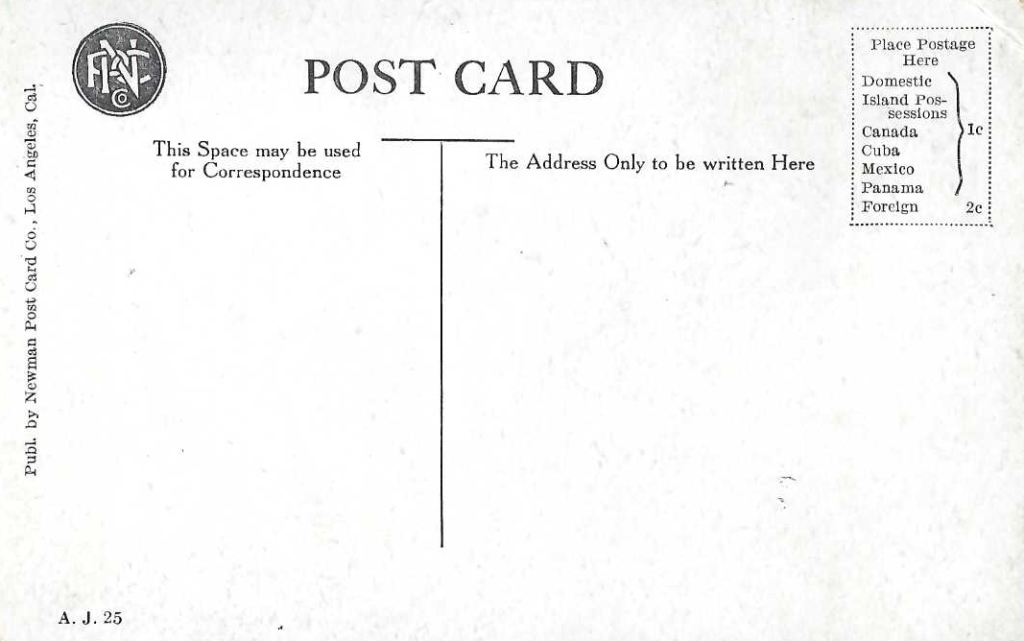
In the A.J. series, this post card, along with A J. 26, are the only two in the series where a non-italicized font was selected for the caption.
The photograph used for A.J. 25 was also used by the Curt Tiech Post Card Company to print a post card for the Souvenir Novelty Company of Salt Lake City. The novelty company card, with the Curt Tiech number, A-35700, is titled Rainbow Canyon, Nevada. On the Salt Lake Route.
There is a second version of A.J. 25. The later version has the same image and the same back. The phrase “On the Salt Lake Route” is printed below the caption “The Los Angeles Limited In Rainbow Canyon, Nev.”
The back of the second version also has a descriptive paragraph of the Los Angeles Limited.

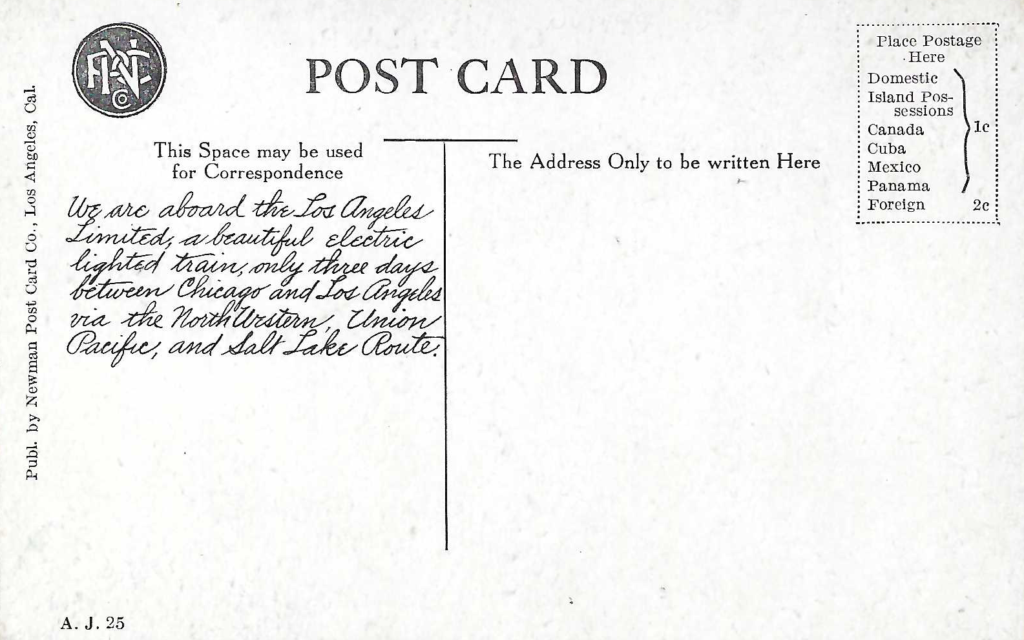
A.J. 26 Overland Express, Palisade Canyon, Nev. The image on the post card is a 180-degree view from the scene in A.J. 24.

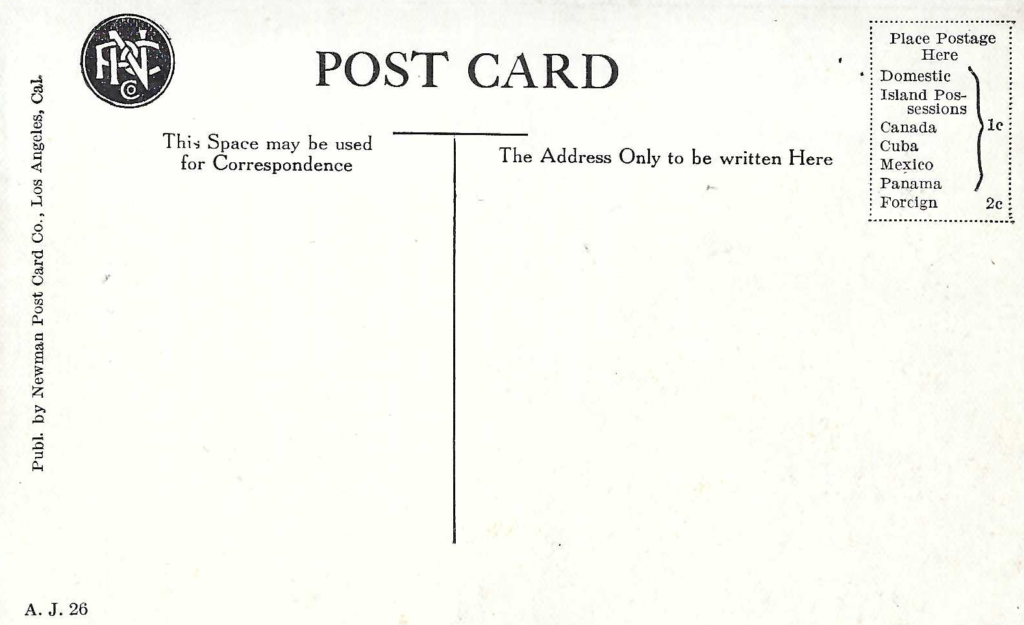
Post card number 26 is the last post card
in the A. J. Tonopah series.
-0-
To determine when the post cards went on sale and when the cards were still being sold, a record of postmarks is being maintained.
Know postmarks on post cards in the A.J. Tonopah Series
1908
June 9, 1908, Tonopah
July 14, 1908 Tonopah
August 25, 1908 Tonopah
Oct. 20, 1908 Tonopah
November 7, 1908 Tonopah
December 8, 1908 Tonopah
1909
Jan. 26, 1909 Tonopah
February 12, 1909 San Jose, California
March 9, 1909 Rhodes, Nevada
April 25, 1909 Tonopah
June 3, 1909 Reno & Goldfield
July 12, 1909 Tonopah
Sept. 9, 1909 Truckee, California
Sept. 11, 1909 Ogden & Francisco RPO
July 12, 1909 Tonopah
Sept. 30, 1909 Tonopah
November 23, 1909 San Bernardino, California
Dec. 24, 1909 Reno & Goldfield, RPO
1910
February 7, 1910 Los Angeles, California
June 2, 1910 Tonopah
June 19, 1910 San Fran., S. Jose & Los Ang. RPO
June 30, 1910 Goldfield, RPO
July 16, 1910 Long Beach, California
Aug. 31, 1910 Reno
October 8, 1910 Tonopah.
October 24, 1910, Los Angeles, California
1911
March 24, 1911 Tonopah
May 23, 1911 Reno & Virginia City RPO
July 7, 1911, Reno & Virginia City RPO
July 10, 1911 Tonopah
August 10, 1911 Goldfield.
Aug. 27, 1911 Tonopah
September 18, 1911 Los Angeles, California
1912
April 23, 1912 Tonopah
October 1, 1912 Tonopah
1913
Feb. 7, 1913 Tonopah
Feb. 8, 1913. Arizona
Sept. 29, 1913 Tonopah
1915
August 7, 1915 Lida
1928
Sept. 7, 1928 Tonopah
[i] https://shpo.nv.gov/uploads/documents/64000532_-_Tonopah_MRA.pdf
[ii] https://shpo.nv.gov/uploads/documents/64000532_-_Tonopah_MRA.pdf
